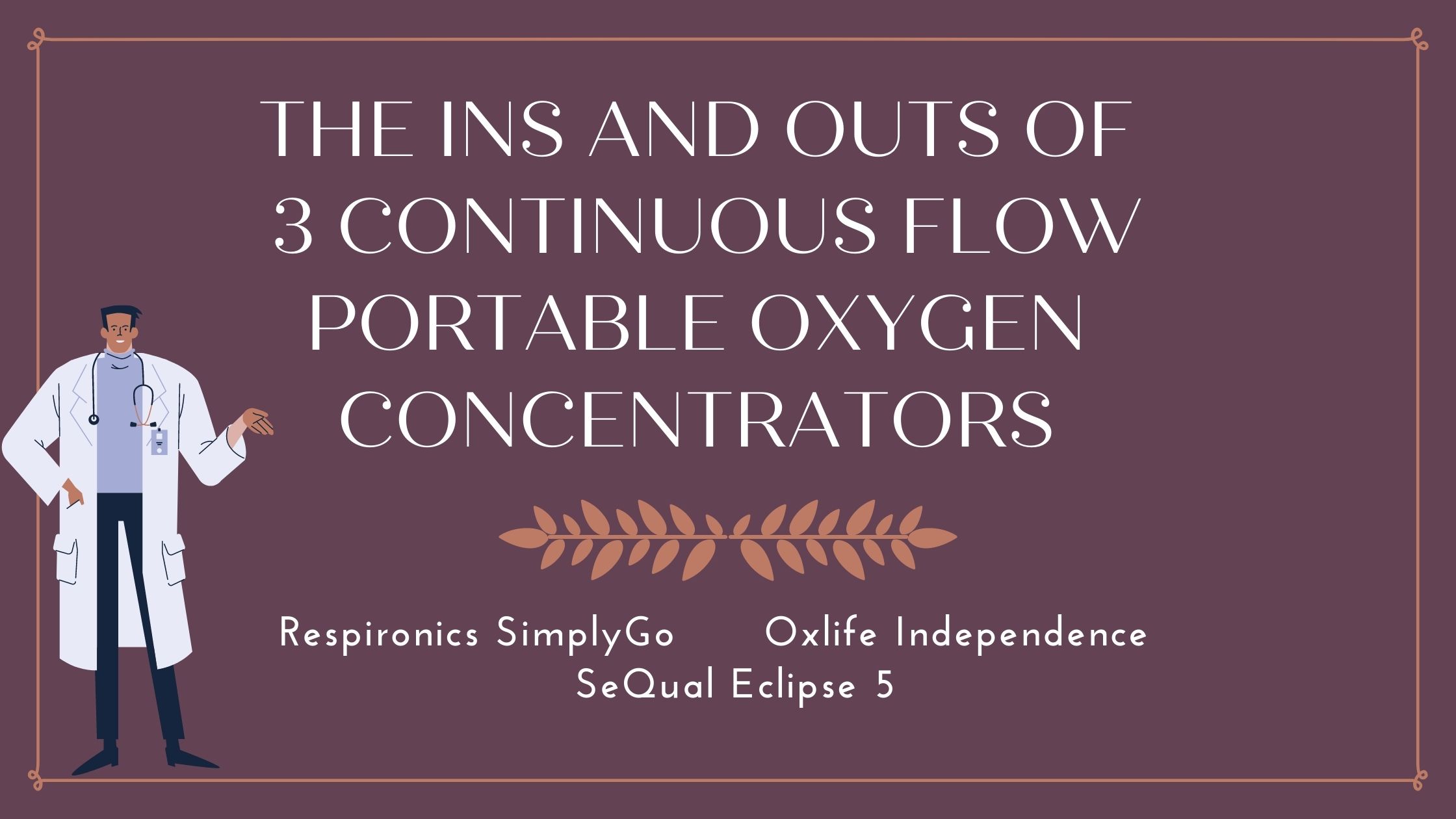
Continuous flow portable oxygen concentrators offer the oxygen patient a constant flow of oxygen. Many oxygen patients require continuous flow only during certain activities like while they exercise or when they sleep, while others need their oxygen continuously flowing at all times of the day and night.
Your oxygen prescription will be unique to you and you should do your best to adhere to the recommendation set up by your healthcare team. We also recommend working with an oxygen equipment company that is a licensed distributor of name brand products.

Oxygen patients should also be wary of the medical supply company your doctor office refers you to, because this is not always the company that wants to work with you to find the right device for you. Some people will order their oxygen device from sites like Amazon because they are cheaper, but what they do not realize is these machines are faulty and not only do they break easily, you will not get the medical grade oxygen you body needs.
When you work with an experienced respiratory specialist, they will ask you a series of questions, these questions will help them determine whether or not a portable oxygen concentrator will cover all of your oxygen requirements within your supplemental oxygen prescription. Your specialist should also be curious about your lifestyle and your wants and concerns as an oxygen patient, in order to best match you with the oxygen device that is going to be suited to your lifestyle.
When you work with LPT Medical, we require a doctor's prescription before anything else. This way we can be sure that your device will be compatible with your oxygen requirements.
This protocol also ethically binds us to the agreement that we will not sell medical grade oxygen to respiratory patients who do not qualify for it. Secondly, we want to know about you, what are your hobbies, do you like to travel, what are your respiratory goals? This way we can match you with a device that will help you reach your goals rather than hold you back.
Once we have established your oxygen requirements, we will take you through the different specifications of our devices and the pros and cons of each portable oxygen concentrator, and from there, you will feel confident choosing a device.

In this blog, we will discuss your options as a continuous flow oxygen patient. If you gave LPT Medical a call today at 1(800) 946-1201, and you were a continuous flow oxygen patient we would go through these options for you:
- Respironics SimplyGo
- Oxlife Independence Portable Oxygen Concentrator
- SeQual Eclipse 5 Portable Oxygen Concentrator
In this article we do not discuss any of our portable oxygen concentrators costs because our prices are lower than the manufacturer's prices, therefore we are obligated not to advertise our low prices online. To learn about how we can help make your oxygen equipment more affordable, please call us today at 1(800)-946-1201 to learn about your options.
Respironics SimplyGo
Let us start with the smallest and lightest weight continuous and pulse flow oxygen device on the market!
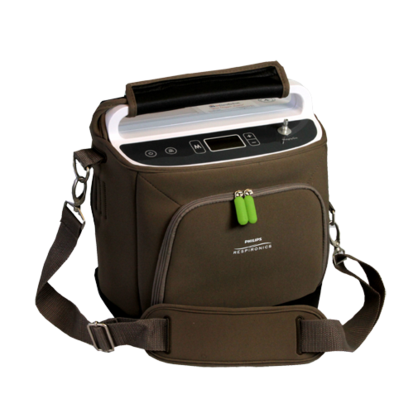
The Respironics SimplyGo is a pulse flow and continuous flow portable oxygen concentrator that only weighs 10 pounds. 10 pounds is about as heavy as a gallon of milk, and this is still considered heavy for many oxygen patients. That is why the Respironics Simply Go comes with a wheeled cart and an over the shoulder carrying case, so you have multiple options to carry the device depending on what you are doing.
Activities you can Accomplish with the Respironics SimplyGo
If you are an active person, you can get a lot more done with the SimplyGo than you would lugging around a bulky liquid or gas oxygen tank. This is because the SimplyGo was designed to be portable, so it has a compact and simple design that makes wheeling it behind you a breeze.

You can go for long walks because the battery life of the Respironics SimplyGo can last for up to up to 2.9 hours with a single battery. With the SimplyGo you have the option to use the external battery module, allowing your device to operate while using two batteries, this gives you even longer to be out and about with your oxygen device while traveling, during road trips, and extended trips away from your home!
The wide range of flow settings on the SimplyGo gives you the freedom and independence to manage your condition confidently on your own. You will never have to wait around for an oxygen delivery service to bring you new oxygen tanks, instead you can dial in your pulse flow settings of 1-6 and your continuous flow settings 0.5-2.0 LPM to match your oxygen prescription.
Exercise
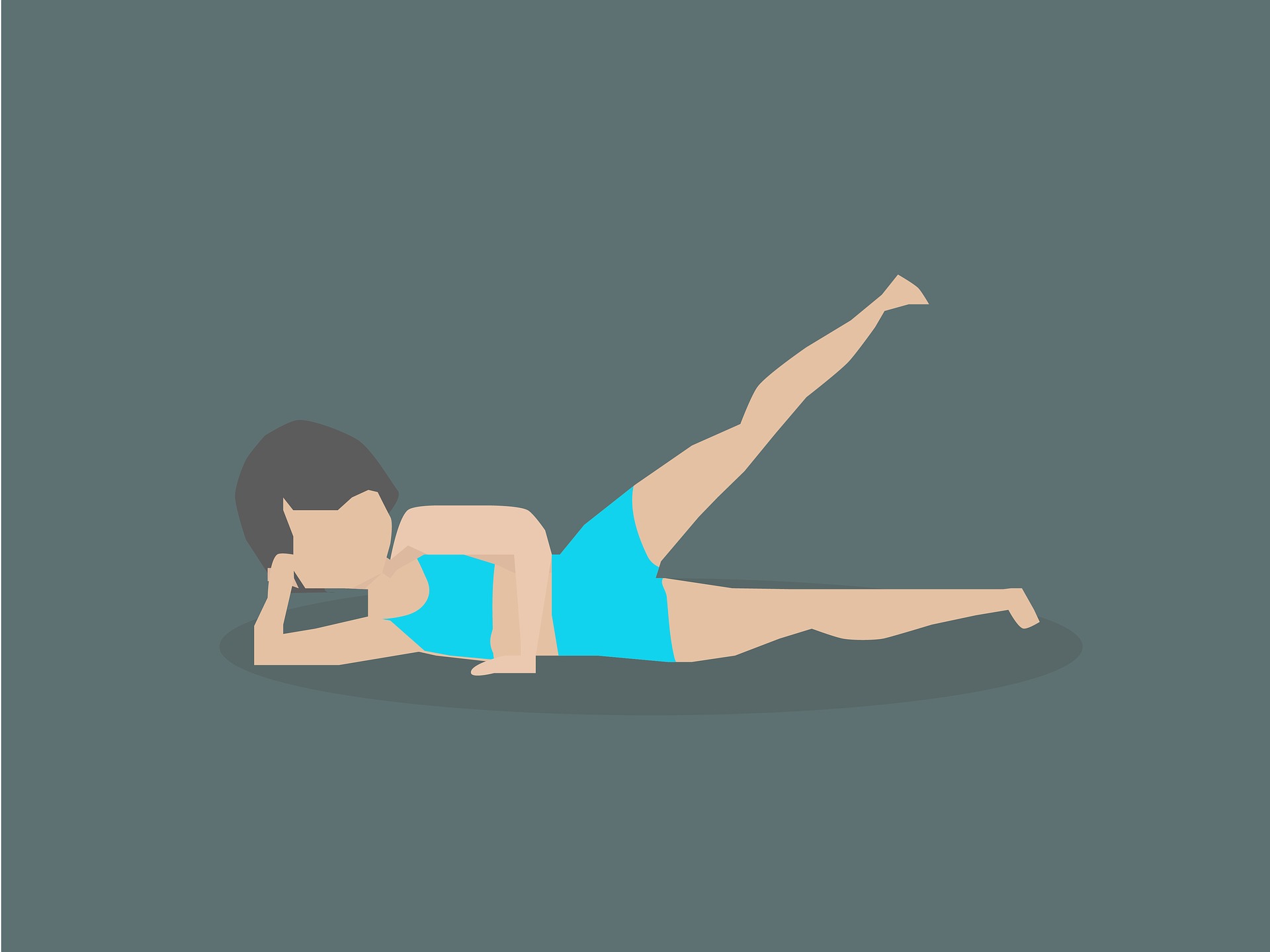
With these strong pulse flow settings and the ability to reach 2.0 LPM on continuous oxygen flow, you will be able to start exercising or continuing to exercise daily. Exercise for respiratory patients is crucial. Exercise helps to slow down the deterioration in your lungs if you have a chronic respiratory disease, and daily exercise can help to strengthen your muscles and your lungs thereby improving your overall quality of life.
Travel
![]()
If you enjoy traveling, whether it is by air plane, car, RV, or even boat, your Respironics SimplyGo will help you get to your destination worry free. All of our portable oxygen concentrators are FAA approved, and taking them with you on a plane is simple and manageable.
The Respironics SimplyGo is a compact device, its’ dimensions are 10” H x 6” D x 11.5” W, so it can easily fit under the seat space in front of you during your flight in the car during a road trip.
If you travel long distances, you might be worried about the battery life of your device.
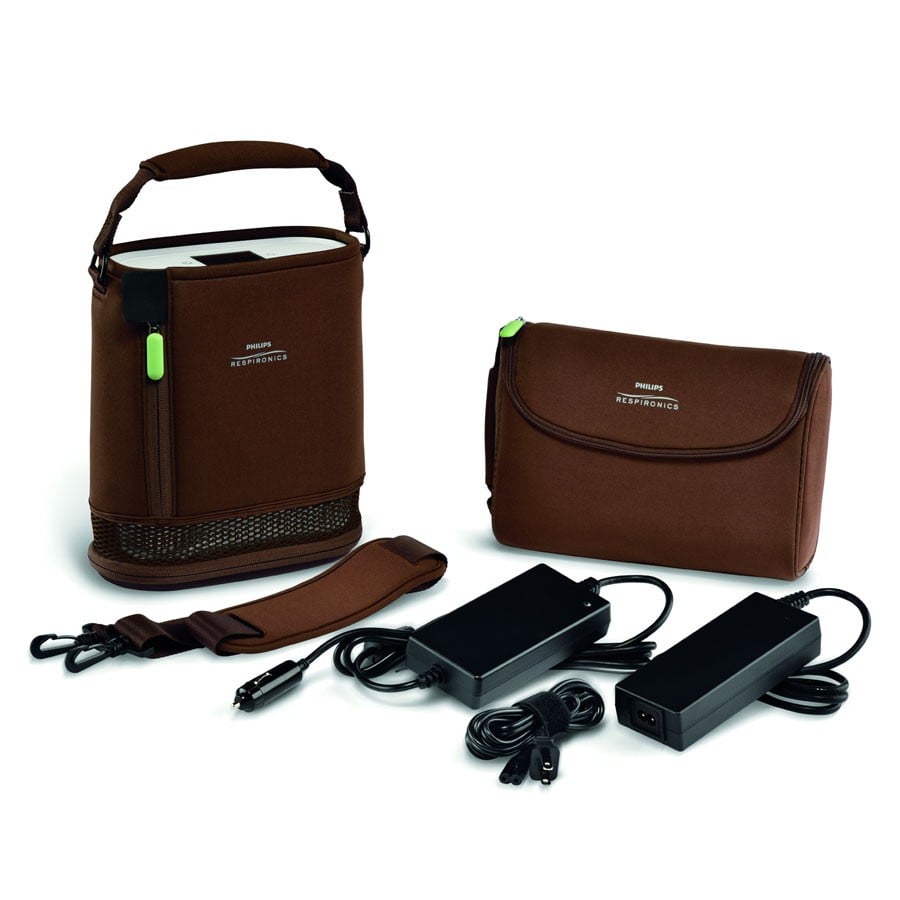
If this is the case for you, you can always purchase the Respironics External Battery Charger which gives you the ability to recharge your batteries without plugging your concentrator into the AC or DC power cables the device comes with. It’s a single-bay charger and recharges one battery at a time. It’s equipped with a 110v power cord allowing you to plug it into any 110v wall outlet.
The external battery charger also has the ability to recalibrate your batteries! If you ever feel like your batteries aren’t holding a charge like they used to, simply recalibrate them on your charger.
You can also get the external battery module, this is a device that connects to your Respironics SimplyGo allowing you to attach a second battery. Essentially, you are able to double the battery life of your Respironics SimplyGo, affording you more time with oxygen before you have to charge the device again.
If you are traveling by plane a lot, it would be wise to look into the airline’s plug in capabilities, because there are a lot of planes that offer AC charging docks, in which case you could charge the batteries, use your oxygen device, and flight across the country at the same time.
Oxlife Independence Portable Oxygen Concentrator
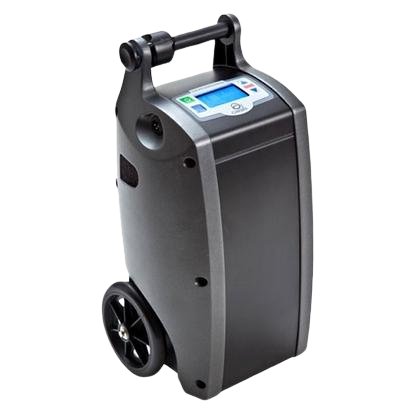
O2-Concepts is probably a name you haven’t heard much about in the oxygen industry, but the Oxlife Independence portable oxygen concentrator by O2-Concepts is right up there on the list of the best continuous portable oxygen concentrators. It’s a sleek looking unit that is extremely durable and offers a number of different features that work to make your life easier!
Whether you’re looking for a concentrator to travel with or you want something for everyday use, the Oxlife Independence is capable of supplying you with oxygen 24/7.
Cutting-Edge Technology
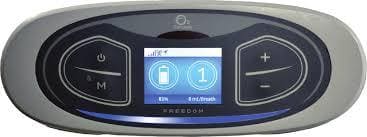
The Oxlife Independence is the world’s first “smart” portable oxygen concentrator. It is equipped with DNA technology which is powered by the Verizon network. DNA technology takes the Oxlife and puts it in its own class of concentrators.
With DNA technology, your Oxlife Independence will monitor your usage and corresponding environmental conditions to adapt and proactively support your needs. It tracks vital data like hours used, breathing rate, ambulation, and more!
Life PT Medical and O2-Concepts will be able to remotely monitor your concentrator and your machine will notify us if there is anything wrong with the unit. And should the unfortunate event happen where someone steals your concentrator or it somehow gets lost, DNA technology lets us find it’s most recent location!
Reliable and Durable to Withstand the Trials and Tribulations of Time
.jpg)
The Oxlife Independence is durable, but it is also user friendly. The hard-bodied shell protects your Oxlife from everyday wear and tear and accidental bumps,
The most unique feature on the Oxlife Independence is the integrated travel cart. Most continuous flow portables have to be secured to a cart before use. The Oxlife’s integrated cart provides you with seamless transitions from storing to using your concentrator. The folding handle allows you to have your Oxlife ready to store or ready to use in seconds.
The large wheels make it easy to maneuver in large crowds, around your house, and while you’re exercising. They make it so you won’t have to worry about going up curbs/stairs or avoiding puddles outside. And they are replaceable in case anything happens to them!
Built to Last
{{cta('fa8abc2a-1e88-4fa3-82fd-1cb5b9ed43b2','justifycenter')}}
The Oxlife has a built in compressor rated to last up to 20,000 hours! You will be able to depend on the device 24/7 without a problem, even if you use a CPAP or BiPAP device while you sleep. It offers both pulse flow and continuous flow delivery modes so if your oxygen prescription changes over time, your device can be adjusted to cover your needs rather than needing to buy a new one.
On pulse flow it goes from 1-6 and on continuous flow it goes from 0.5-3.0 LPM so the device is powerful enough to cover most oxygen patients with some wiggle room to crank up the flow in the case of an emergency or other instances when you need a higher than normal flow.
Great Battery Life
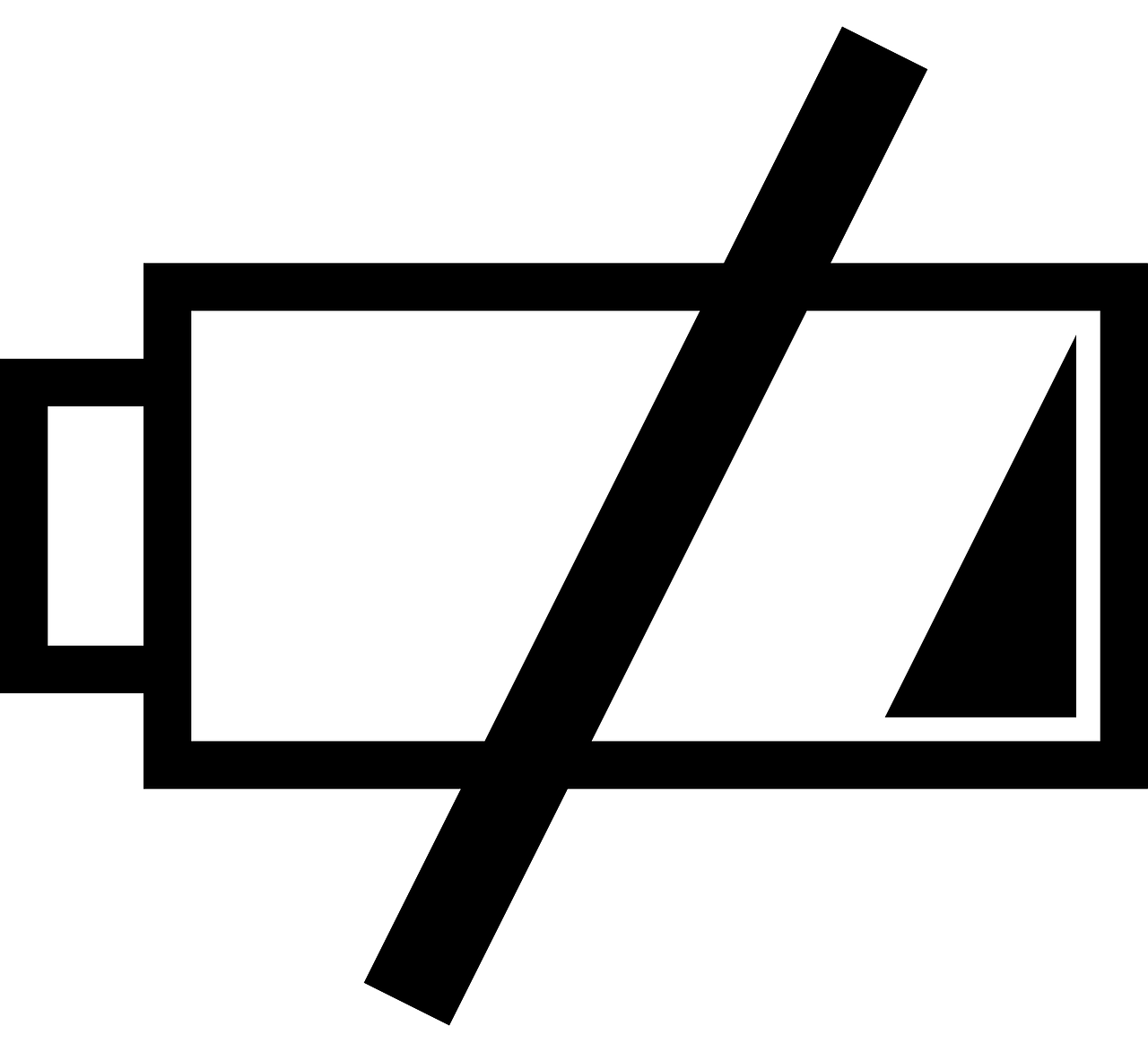
Battery life is one of the most important features in a portable oxygen concentrator and when you are looking into buying a portable oxygen concentrator, looking for a device with efficient flow to battery life ratio is essential. The Oxlife Independence has the ability to operate using one or two batteries, and it gets great battery life for a continuous flow machine.
With one battery you will get up to 1.25 hours of battery life on a setting of 2 LPM and up to 3.00 hours of battery life on a pulse setting of 2.
With two batteries you will get up to 2.5 hours of battery life on a setting of 2 LPM and up to 5.75 hours of battery life on a pulse setting of 2.
This goes to show how much you can accomplish with a Oxlife Independence by your side!
SeQual Eclipse 5 Portable Oxygen Concentrator
The SeQual Eclipse 5 is the 4th generation model in SeQual’s extremely popular Eclipse line of concentrators. In fact, the Eclipse 5 is one of the best selling and most reliable continuous flow portable oxygen concentrators on the market. It offers the highest oxygen output on the market, gets good battery life, and it was also designed for the US Military.
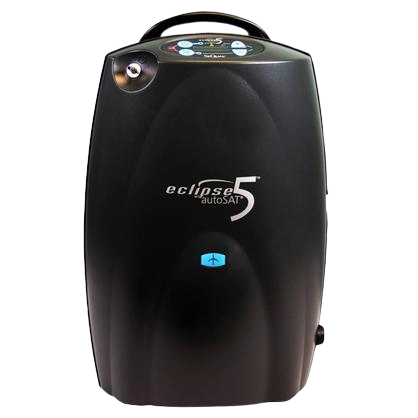
Most Powerful Continuous Flow Portable Oxygen Concentrator
The SeQual Eclipse 5 has the highest oxygen output on the market. It offers pulse flow settings 1-9 and continuous flow settings 0.5-3.0 LPM. With such a wide range of oxygen settings, the Eclipse 5 can accommodate most oxygen patients and it will be able to adjust to your needs when needed!
Along with offering pulse flow settings 1-9, the Eclipse 5 is equipped with Auto-Sat technology. Most portables that offer pulse flow can only provide a fixed amount of oxygen per minute based on your breathing rate.
With Auto-Sat technology, you don’t have to worry about that. Whether you are walking upstairs, exercising, or simply having a bad breathing day your SeQual Eclipse 5 will monitor your breath rate and give you a consistent bolus dose every time it detects a breath.
That’s not the only way the Eclipse 5 guarantees that you get your required oxygen though…
When you are using pulse flow and your Eclipse 5 doesn’t detect a breath, you will still get your oxygen! So if you dozed off watching a movie, flying on an airplane, or riding in the car and your Eclipse 5 doesn’t detect a breath, it will automatically switch over to continuous flow to keep providing you with oxygen.
Durable and Reliable
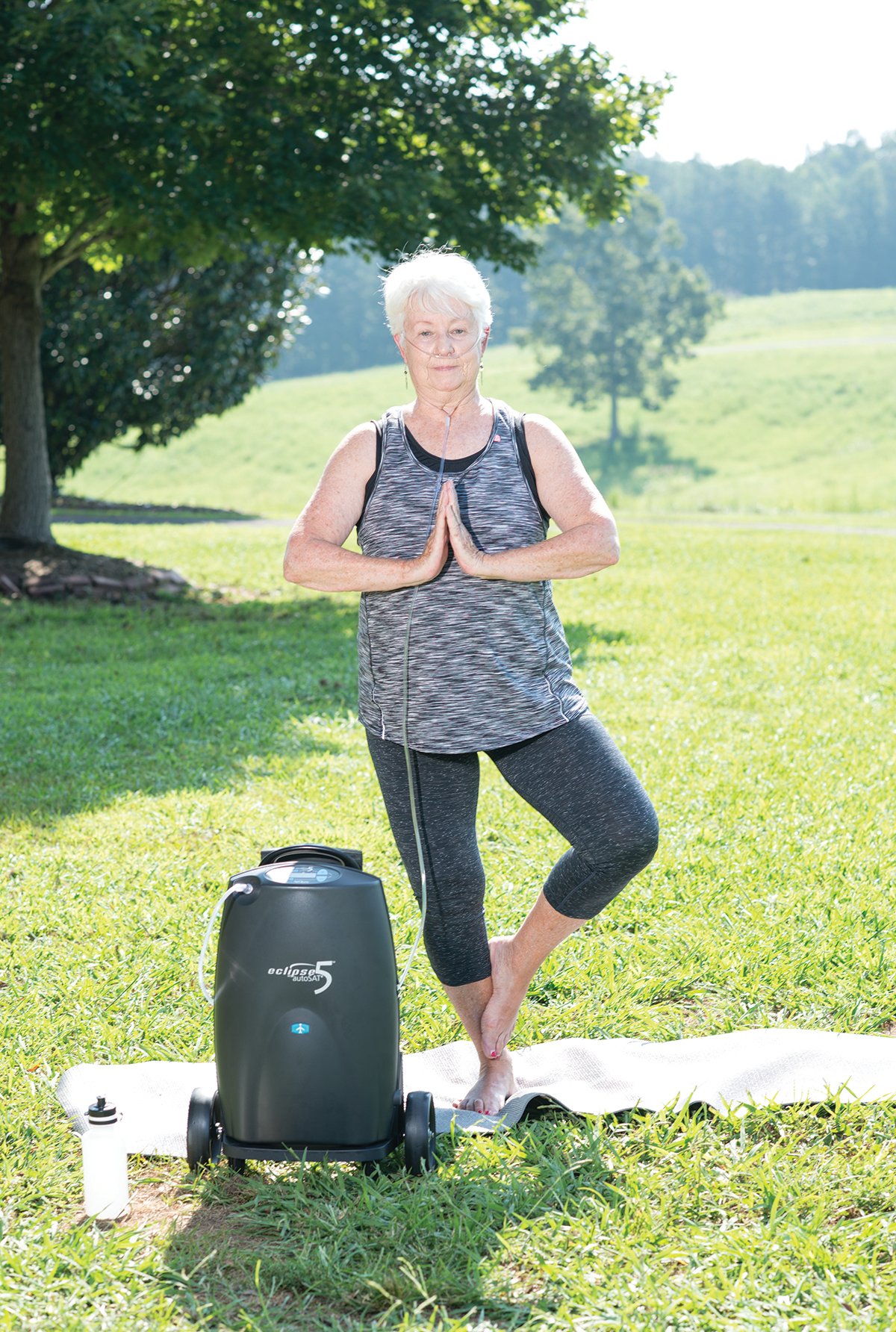
The SeQual Eclipse 5 is one of the most, if not the most, popular continuous flow portable oxygen concentrators on the market. That is largely due to its long-standing track record for being durable; it was designed for the US Military, that should tell you something.
The hard-bodied shell of the Eclipse 5 is extremely protective. It can withstand bumps and bruises with any damage, so it will last a lifetime.
One of the best things about the Eclipse 5 is that it requires very little maintenance from you to keep it running. All you need to do is clean out your oxygen filter once every week or two in order to make sure your are getting purified oxygen depending on how often you use your Eclipse.
Portable and Easy to Travel With
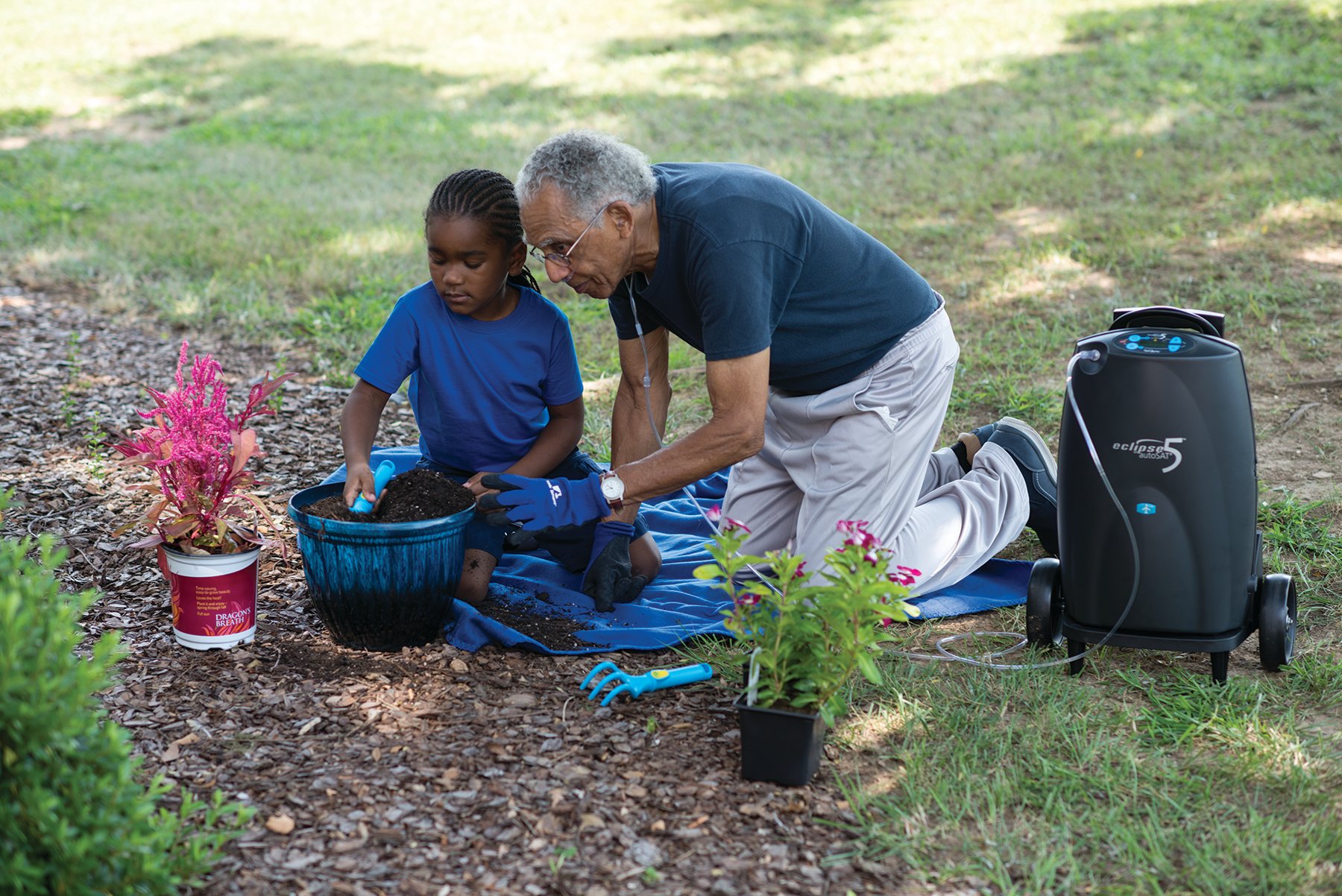
Despite the SeQual Eclipse weighing upwards of 18 pounds, it is simple and easy to take with you wherever you go.
It comes with a wheeled travel cart with smooth wheels that makes pulling your concentrator behind you seem effortless.
The oversized wheels, elevated platform, and telescopic handle make going up curbs and stairs a breeze.The design also protects your concentrator from water when you have to go over puddles or when it’s snowing.
The telescopic handle lets you adjust the travel cart to the height that is most comfortable for you! And if you ever need to store your concentrator the handle slides all the way down and locks. So if you’re traveling you can keep your SeQual on the travel cart and it will still fit underneath the seat in front of you!
Depending on the setting of your oxygen flow, the SeQual Equinox can last anywhere from 1.3 hours to 5.9, so the battery life allows you to be about and about longer without having to worry about charging your device.
When you do need to charge your Equinox, it is super simple, and you have multiple options, so no matter where you are, as long as there is a DC or and AC outlet, you will have the tools to charge the device, and you can always continue to use the device while it is charging,
A Simple Comparison

As you can see, there are a few key differences between the SimplyGo, Oxilife, and the Eclipse. For one the SimplyGo weights much less than the Oxlife or the Eclipse. The battery life of the Eclipse and the Oxlife is greater than that of the SimplyGo.
All of the devices are reliable and durable, but the Eclipse is known for its low maintenance requirements.
You can travel by plane, car, boat, or foot with any of these devices, but the Respironics SimplyGo is the most compact and lightest to carry around with you. However, all three are small enough to fit under the seat in front of you while you travel on an airplane. The Equinox has a telescopic handle that makes traveling a breeze.
The Oxlife has DNA technology that can track certain health related information, so this device is great for people who are interested in keeping track of their breathing stats.
It can be overwhelming to look over all of this information and then have to decide on the device you want, which is why we have respiratory specialists waiting for your call. Give us a call if you have any questions or concerns, or simply leave a comment on this blog if you have any questions.
.png)
The novel coronavirus has completely reshaped the way that we view sanitation. Over the past year, organizations and individuals alike have taken steps to control the spread of disease, and the population as a whole has become more aware of the impact of infectious disease. Another thing that people have become more aware of is the impact of chronic respiratory diseases such as COPD, asthma, and pulmonary fibrosis. Studies have shown us that these people are “high risk” when it comes to infectious disease, so we need to take steps to protect their health.
Unfortunately, simply telling someone to “clean more often” or “clean more thoroughly” is bad advice. These statements fail to acknowledge that cleaning products themselves can actually put our health at risk. Many household cleaning products are filled with toxic chemicals that can irritate the eyes, skin, and throat. And in the worst cases, they can even contribute to COPD symptoms by exacerbating chest pain, difficulty breathing, and chronic coughing.
{{cta('b59df0c1-c4de-47a8-8e1c-0d33d4b414aa','justifycenter')}}
In this post, we’re going to provide you with a comprehensive list of steps for cleaning your home as a COPD patient. We’ll give you advice on choosing cleaning products, how often you should clean, and other things you should take into consideration. If you have any questions, feel free to leave a comment. And if you find this information helpful, don’t hesitate to share it to help us get the word out about safe cleaning habits.
How to Choose Cleaning Products With COPD
The first step in cleaning your home is to choose the cleaning products that you will use. While this may sound like the easiest step, it’s actually the hardest. Cleaning products are rife with volatile organic compounds (VOCs). These are compounds that have a high vapor pressure and low water solubility. Many VOCs are artificial meaning they’re man-made, and they contain chemicals such as methyl tert-butyl ether (MTBE), trichloroethylene, oxygenates, and other industrial solvents.
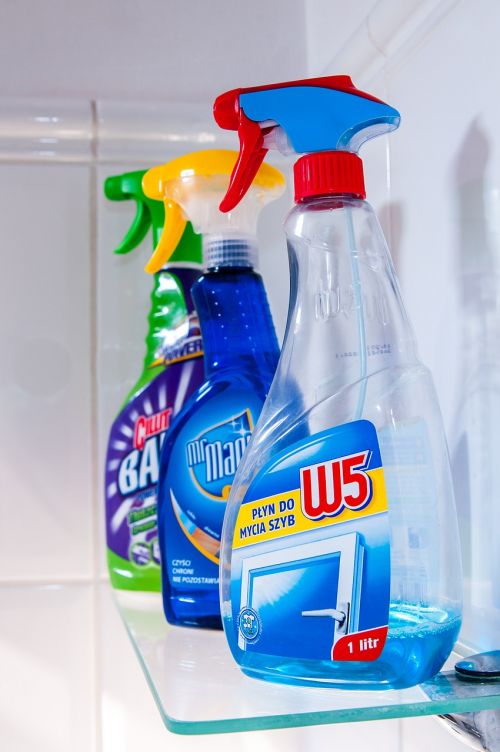
According to the Environmental Protection Agency (EPA), concentrations of VOCs are up to ten times higher indoors than they are outdoors. This is largely due to the fact that VOCs are found in many household cleaning products and many homes are not ventilated well enough to rid them of harmful chemicals. But VOCs aren’t the only harmful ingredients found in home cleaning supplies. Many of them also contain carcinogens, chemicals that are known to cause cancer.
![]()
As a COPD patient, your goal should be to eliminate all hazardous cleaning products from your home. However, it’s especially important to avoid cleaning products that can exacerbate your respiratory symptoms. Products like air fresheners are particularly harmful to COPD patients because aerosol droplets can remain suspended in the air for long periods of time, meaning they can be inhaled. Generally speaking, “scented” cleaning products should be avoided at all costs. While we may enjoy a fresh smell and equate it with a clean home, most of these products contain harmful chemicals.
Before heading out to the store, create a list of ingredients that you should avoid. The ingredients below are commonly used in cleaning products and should be avoided:
- Perchloroethylene (PERC)
- Formaldehyde
- 2-Butoxyethanol
- Ammonia
- Sodium Hydroxide
- Chlorine
Some common cleaning products you should avoid include:
- Bleach
- Spray cleaners
- Fragrance sprays
- Carpet fresheners
- Fabric softeners
- Varnishes
-
Drain cleaners

Another thing to note is that you should be wary of anything labeled “green,” “organic,” or “eco-friendly.” Just because something is “organic” does not necessarily mean that it is healthy or safe. However, you may see products labeled as “safer choice.” These cleaning products are actually regulated by the Environmental Protection Agency (EPA) and they’re aimed at reducing, eliminating, or preventing pollution at its source. In many cases, these cleaning products can be a safer alternative for COPD patients but many of them still contain chemicals.
How to Make Safe Cleaning Products at Home
Believe it or not, homemade cleaning products can be extremely effective and they can also be much safer to use than store-bought items. When you make your own cleaners, you’ll know exactly what’s in them and you won’t have to worry about reading through and researching a long list of ingredients.
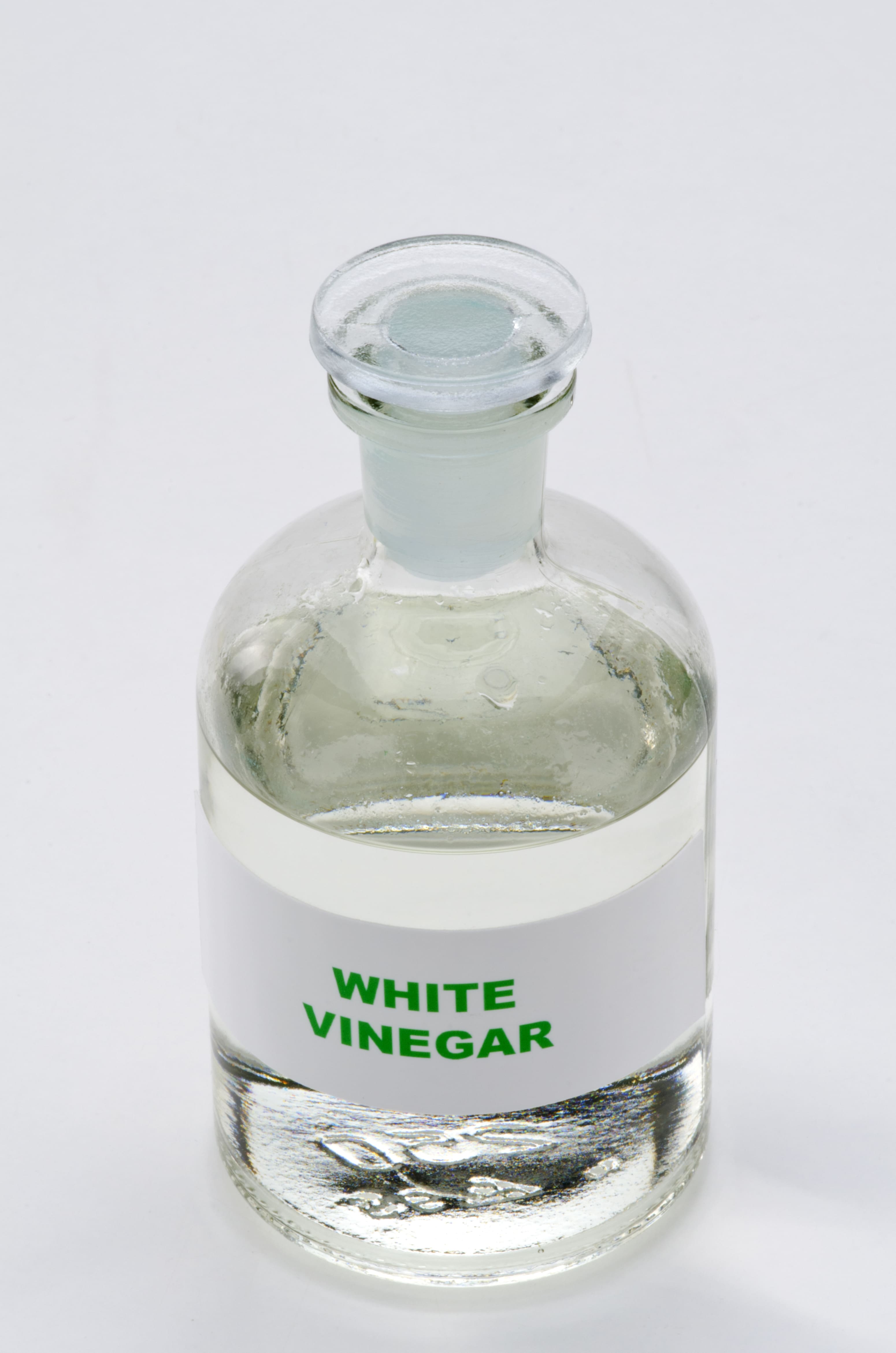
According to Healthline, some of the safest and most effective ingredients you can use to make homemade cleaning products include white vinegar, lemon juice, methylated spirits (denatured alcohol, and baking soda. Unlike the harsh chemicals found in store-bought products, COPD patients typically don’t have any reactions when exposed to these ingredients.

If you want to clean your floor or countertops, combine boiling water with either lemon juice, white vinegar, or methylated spirits. This will make a great degreaser and prove much more effective than a wet rag. If you want to clean a mirror, vinegar and water is a great combination. For removing stains, soda water is your best bet.
Keep Your Home Well Ventilated
Ventilation is imperative when it comes to keeping your home clean. Simply put, ventilation refers to the healthy exchange of air between the inside of your home and outdoors. This prevents harmful chemicals, moisture, and other allergens from concentrating in your home and posing a serious health risk. One of the best ways to ventilate your home is to simply crack a window when you’re cleaning.
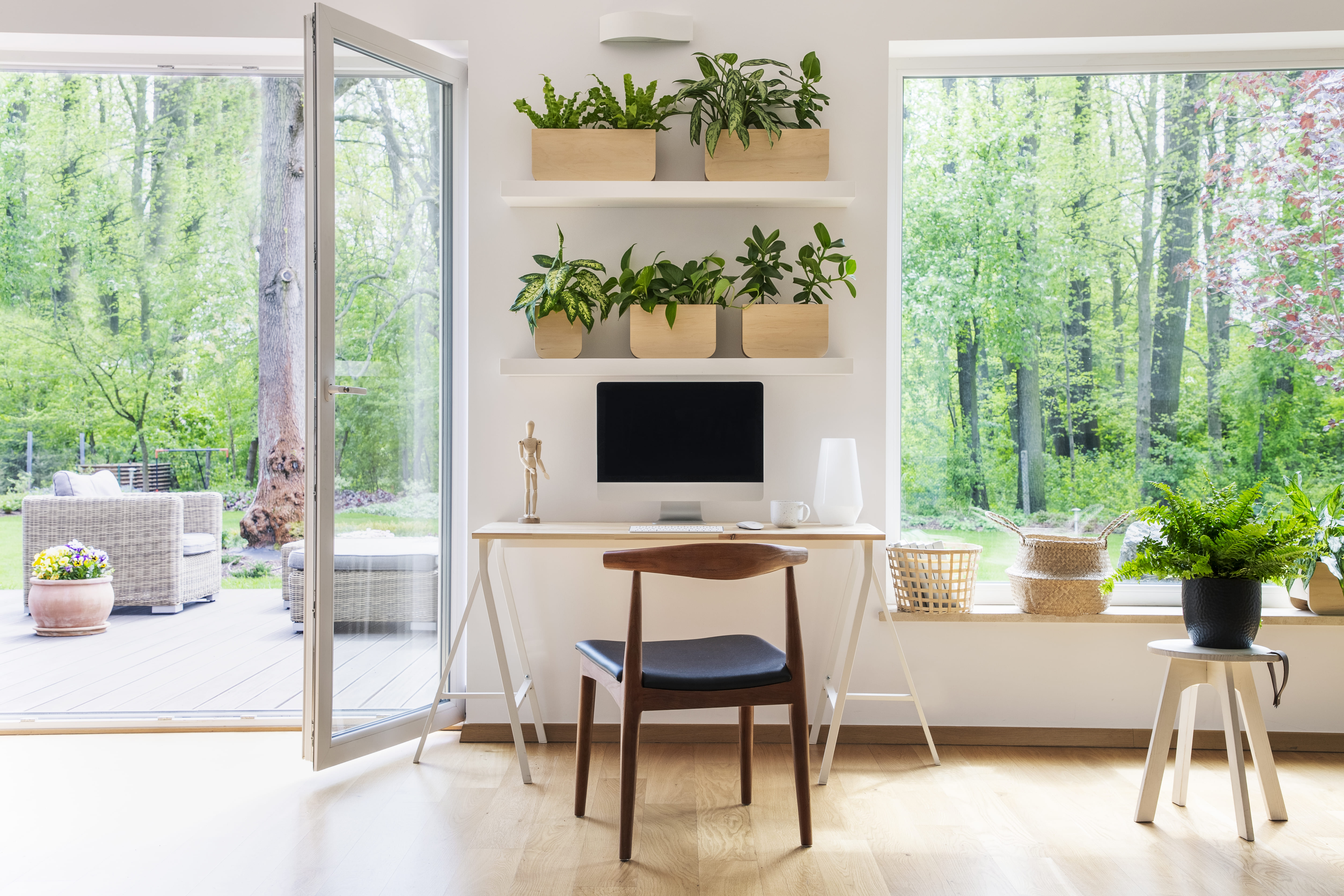
If you’re worried about allergens making it into your home through the window, you can install a screen. While this won’t block out all allergens, it will prevent some of the larger particles from entering your home. Another thing you can do is change up the air filters on your HVAC system. The air filter or “particle filter” is designed to remove allergens from the air as it’s circulated throughout your home. However, over time, these filters can become very dirty. Not only will this start spiking your utility bills, but it won’t filter airborne pollutants correctly.
Choose the Right Tool for the Job
Aside from choosing the right cleaning products, you also need to choose the right tools for cleaning your home. COPD is a debilitating condition so you may need to find creative ways of doing things that won’t add any unnecessary strain on your lungs and the rest of your body. For example, if you need to clean in a hard-to-reach area, be sure to use a cleaning device with an extendable handle. This way, you won’t have to strain yourself or risk falling just to clean your home.
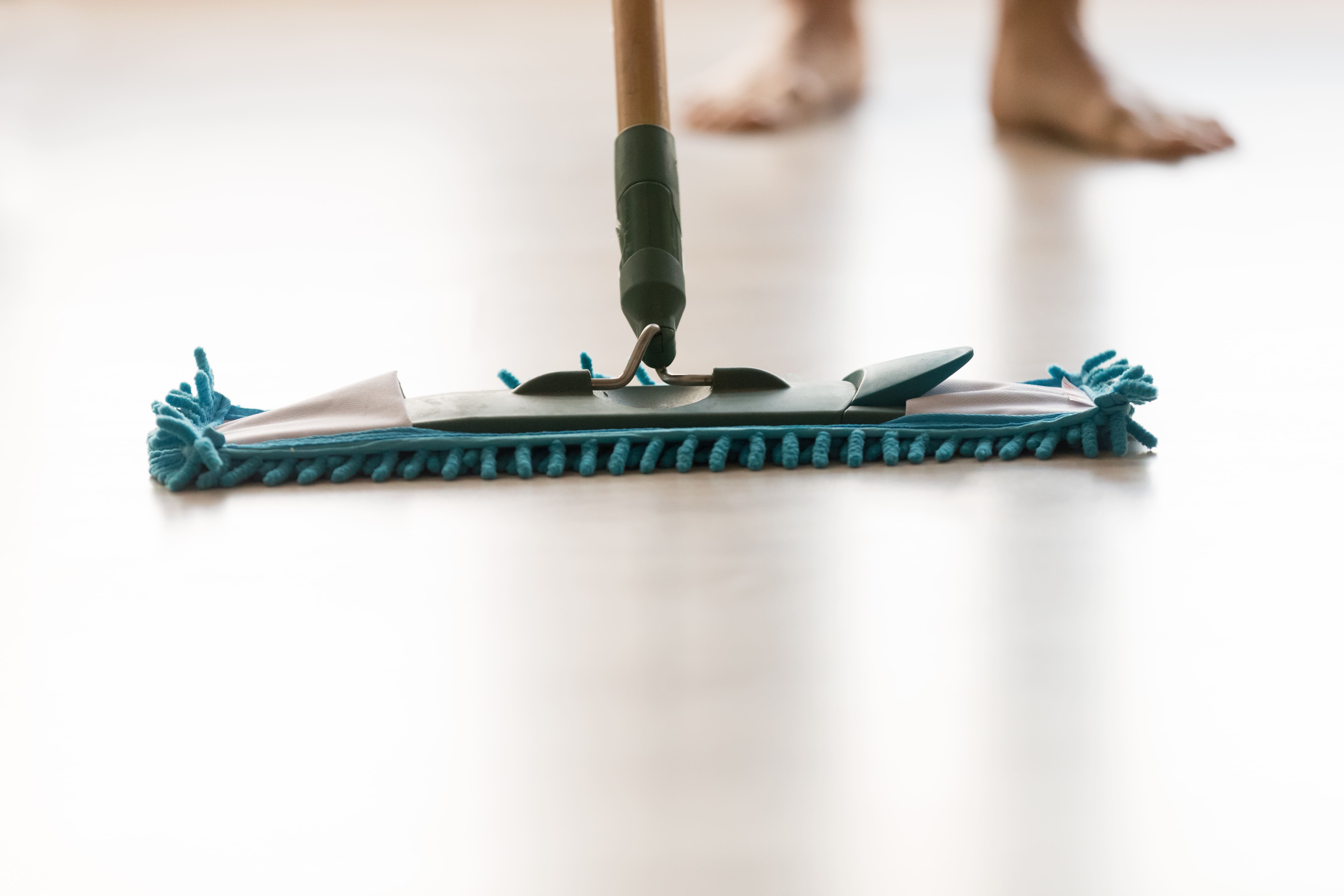
If you’ve been prescribed long-term supplemental oxygen therapy, another thing that can help is a portable oxygen concentrator. If you already use a stationary oxygen concentrator or oxygen tank for your oxygen needs, a portable oxygen concentrator will provide you with much more freedom to navigate your home with ease. Rather than having to be plugged into a wall outlet, POCs operate off of powerful lithium-ion batteries so you won’t be relegated to one room of the house.
{{cta('fa8abc2a-1e88-4fa3-82fd-1cb5b9ed43b2','justifycenter')}}
Portable oxygen concentrators like the Caire FreeStyle Comfort and Inogen One G5 are very lightweight and compact, so you can carry them around all day without feeling exhausted or out of breath. The FreeStyle Comfort even has an ergonomic curve design that will prevent the unit from sliding around at your side while you’re cleaning the house. Once you’re ready for a break from cleaning, simply plug your device into the wall and by the time you’re ready to go again, you’ll have a full battery.
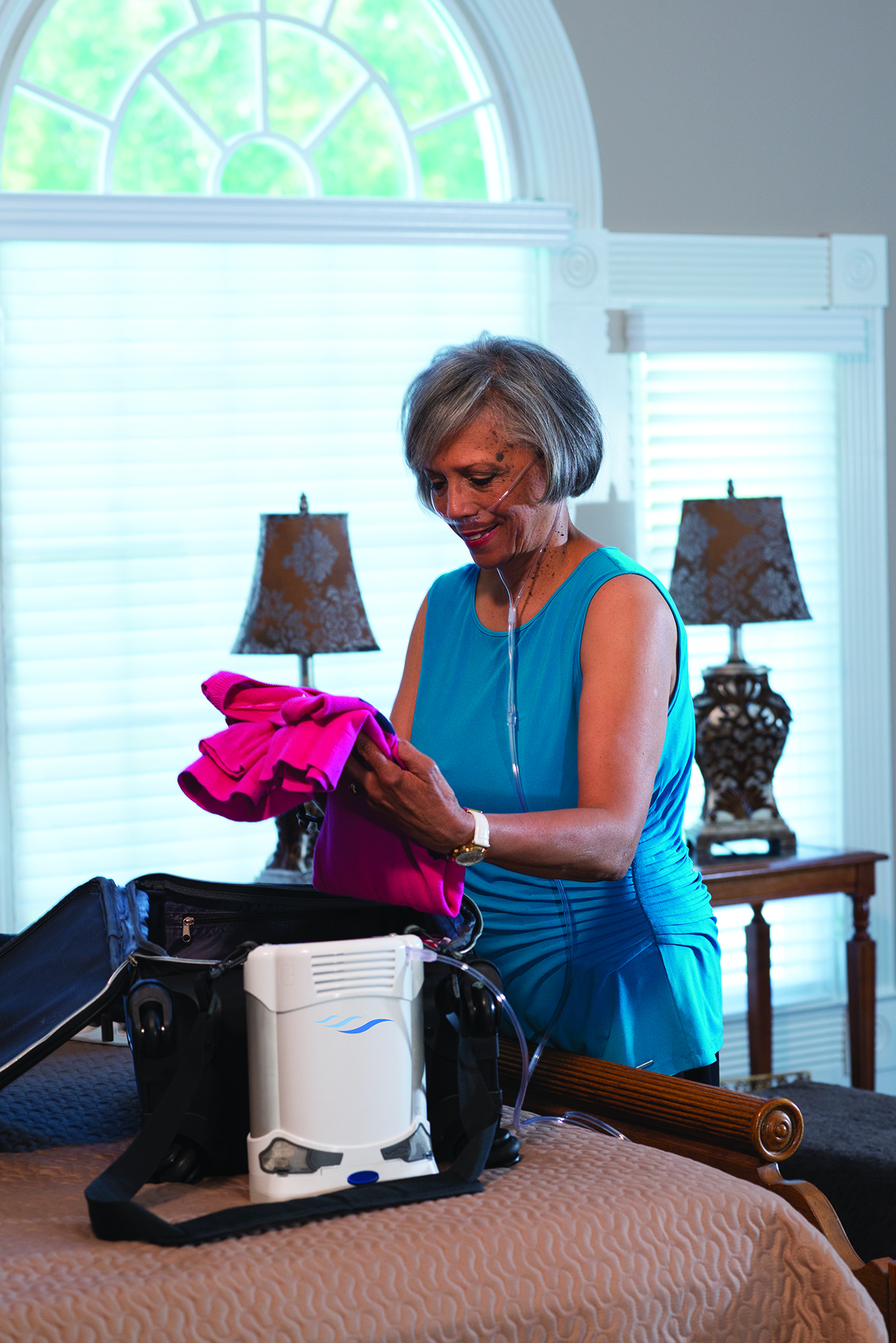
If you’re someone who needs more oxygen to keep you going, the Respironics SimplyGo may be the portable oxygen concentrator for you. This is a continuous flow unit meaning it puts out a constant stream of oxygen rather than “boluses” of oxygen like the FreeStyle Comfort and the Inogen G5. While the Respironics SimplyGo is a bit heavier than these two, it will provide you with more options including the ability to use your POC with your CPAP or BiPAP machine while you sleep.
Don’t Forget to Declutter Your Home
While you’re up and about cleaning your home, it’s also a good idea to spend some time decluttering your home. “Decluttering” simply means reorganizing or getting rid of some of your belongings in order to make your home more comfortable and easy to navigate. This is very important if you’re a COPD patient because having to navigate a messy home can be very challenging and dangerous.
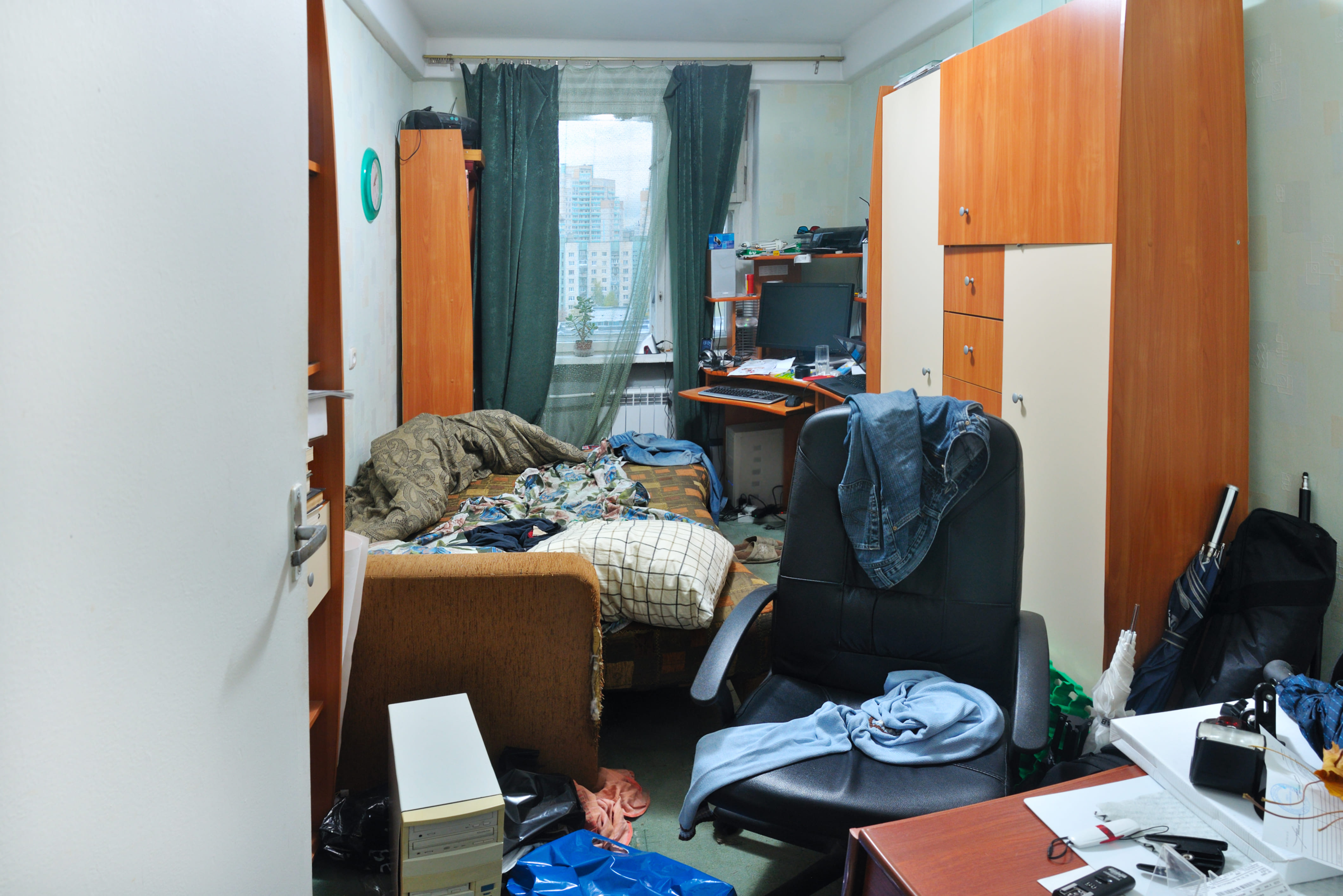
We briefly discussed decluttering in our post about COPD and balance issues, but the basic idea is that you want to create a living space that’s accommodating of your lung condition. First and foremost, you should remove any belongings from the floor that could be a tripping hazard such as clothing, cables, and even furniture. Taking the time to move these things out of the way of where you walk in your home can go a long way toward making your home safer and more accommodating for you and your guests.
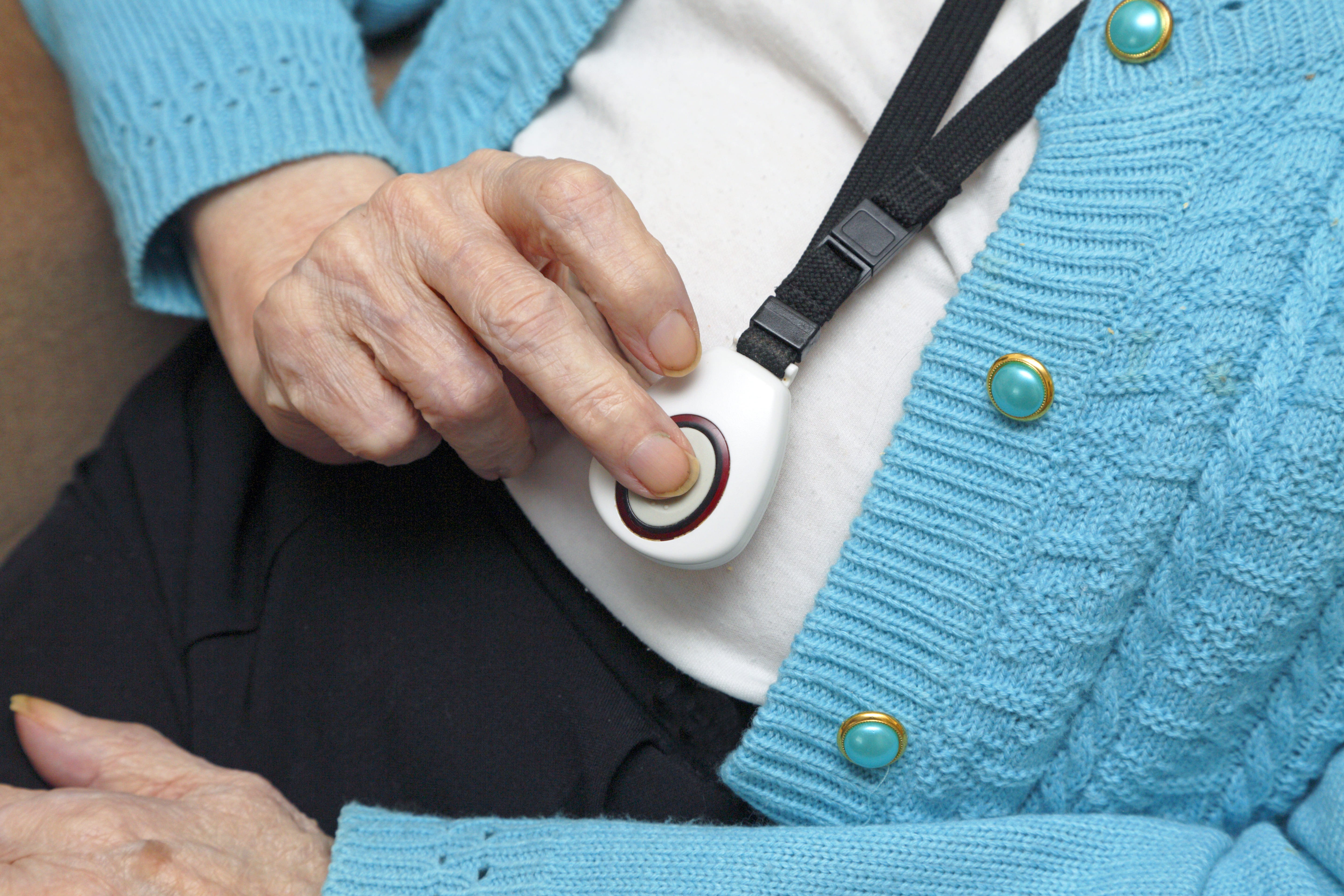
If you want to go the extra mile, you might want to consider installing a medical alert system in your home. This consists of a receiver that’s plugged into the wall and a small button that can be worn around your neck. If you take a fall or experience a COPD exacerbation in your home, simply press the button and medical personnel will immediately be sent to your home. These are a must-have for any COPD patient, especially if you don’t have friends or caretakers who visit your home regularly.
Get Outside When You Can
According to the EPA, indoor air pollution can be 2 to 5 times greater than outdoor air pollution. The reason for this is because indoor air pollutants are concentrated in a small area whereas outdoor air pollution can dissipate. While you can and should take the time to clean your home, you should be going outside as much as possible to get some fresh air.

AirNow.gov has a great air pollution map that will give you a good idea of how clean the air is in your area. Simply visit their site and type in your ZIP code. You’ll be given a number anywhere between 0 and 500 with 0 being the least polluted and 500 being the most polluted. It’s recommended that COPD patients avoid going outside if the air quality index (AQI) is over 100. However, people with severe COPD may only want to go outside when it’s below 50 AQI.
.jpg)
While the AQI is a good indication of the air quality in your area, it’s not 100% accurate. If you live in a very urban area with a lot of traffic, the air quality may be lower than what the website tells you. As such, it’s important to use your best judgment before going outside. Try going out when traffic has settled down and try to stay away from the roads as much as possible.
The temperature is another important factor to consider before going outside. Extreme conditions of any kind can lead to exacerbation of COPD. Low temperatures can be particularly difficult for COPD patients because inhaling cold air can thicken your mucus making it more difficult to breathe. Hot temperatures can cause you to feel exhausted more quickly and also exacerbate respiratory problems.
![]()
Schedule a Home Inspection
If you want to take the extra step towards making your home as accommodating as possible for your COPD, you should consider scheduling a home inspection. This is when a professional safety inspector walks through your home and performs a variety of tests designed to determine the safety of your home. While you may think of a home inspector as someone who examines the structural integrity of a home, they also play an important role in determining its cleanliness as well.
One important thing your home inspector will do is evaluate your HVAC system. This includes things like your heater, air conditioner, air ducts, and air filters. He/she will check to ensure that there are no leaks and that your system is circulating clean air throughout your home. The inspector will also look for water damage or plumbing leaks throughout the home that could lead to the growth of mold. Several types of mold, like black mold, can be very hazardous to your health. Black mold poisoning is associated with a chronic cough, fatigue, and irritation in the throat and eyes.
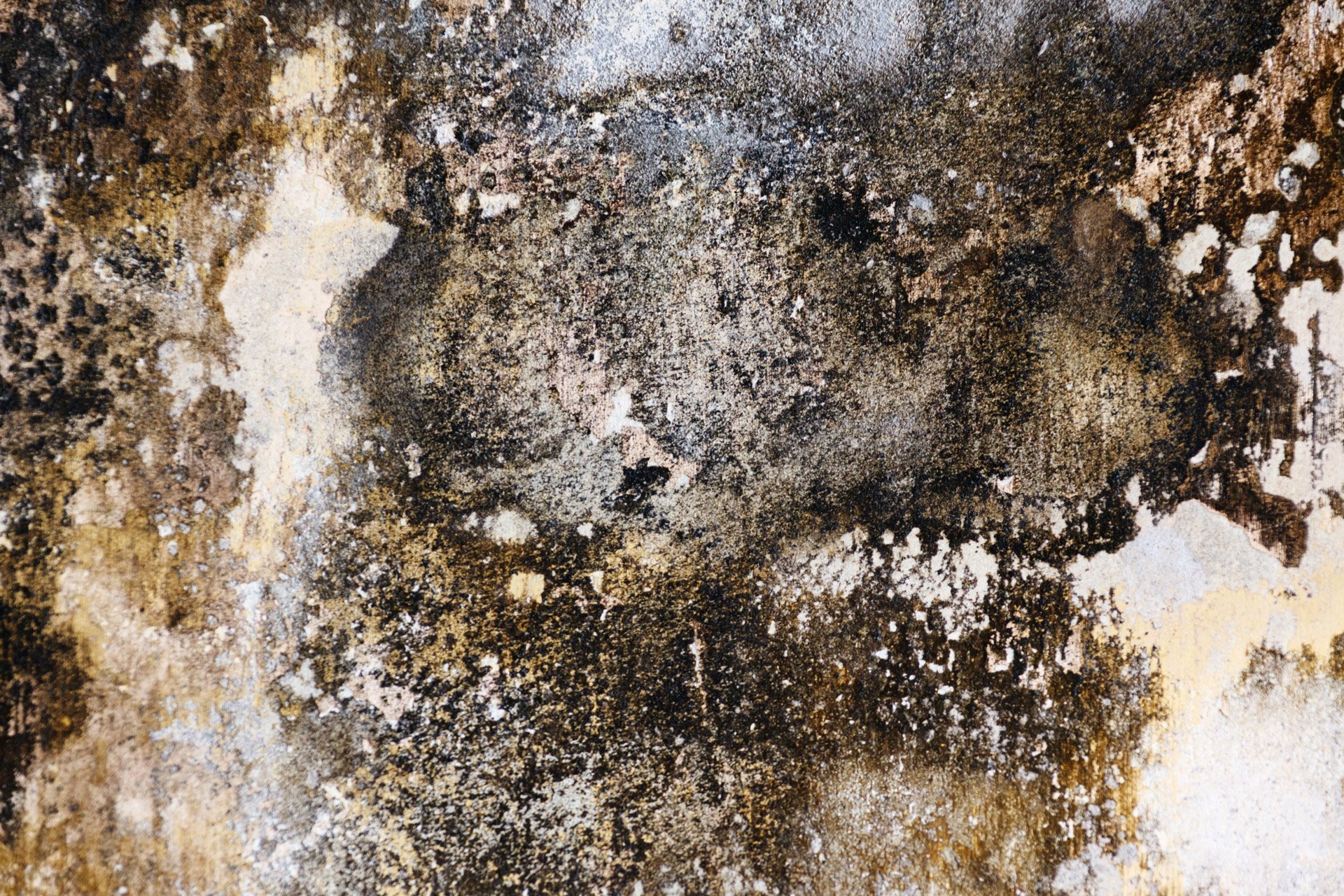
Home inspectors won’t fix these issues within your home. Rather, they provide you with a list of potential problems in your home and advise you on what to do or who to call to get the issues resolved. However, hiring a home inspector is still a very important step because you may be exposed to harmful airborne irritants unknowingly. Many people live with health issues for years only to find out they had a mold or HVAC problem that they were unaware of.
Recruit Help With Cleaning
There’s no doubt about it, cleaning can be exhausting. If you feel like you have a lot to clean and not a lot of time to do it, you may want to start outsourcing work to friends, family, or even a caretaker. While physical exercise is a must for any COPD patient, too much exercise or overexertion can lead to a flare-up in your symptoms, most notably chest pain, breathlessness, and fatigue.
.jpg)
There’s no shame in asking for help with cleaning your home, especially when your well-being is at stake. However, if you decide to recruit help from a friend or family member be sure to let them know about your safe cleaning routine. Let them know that you’re concerned about the chemicals in common store-bought cleaning products and show them how to make the homemade cleaning products we discussed earlier in this post.
{{cta('43b79c5e-6bd6-4f02-ac27-2d038d20c146','justifycenter')}}
Conclusion
Maintaining a healthy living environment is one of the most important things you can do as a COPD patient. Poor air quality in your home will not only irritate your skin and eyes, but it can damage your lungs and lead to flare-ups in your respiratory symptoms. COPD patients who do not breathe clean air are more likely to experience exacerbations that can lead to hospitalization.
Unfortunately, simply cleaning more often or more thoroughly is not the solution. You need to be careful about what cleaning products you’re using and how they affect the quality of air within your home. You should also take additional steps like ensuring your home is well-ventilated and that you’re keeping dust and mold in check.
If you found this post useful, don’t forget to bookmark it so you can refer back to it in the future. And if you have any questions or concerns, please don’t hesitate to leave them in the comment section below
.png)
Chronic obstructive pulmonary disease (COPD) is one of the most common lung conditions in the world. It’s known for developing slowly over the course of many years, leading to increased breathlessness, chest pain, coughing, and wheezing. As this incurable disease progresses, flare-ups and exacerbations become more common, so COPD patients need to pay especially close attention to the treatment plan created by their doctor. Since a core aspect of most treatment plans involves supplemental oxygen therapy, it’s also important for COPD patients to find an oxygen device that serves their long-term goals.
Unfortunately, the medical oxygen industry can be very confusing, especially for someone who’s never had to navigate it before. People who are buying oxygen for the first time often fall victim to false advertising, scams, or they simply end up purchasing an oxygen device that doesn’t meet their needs. As such, we strongly encourage oxygen patients to do their research and understand what oxygen devices there are before buying one. Here at LPT Medical, we take pride in providing oxygen patients with the resources they need in order to make educated decisions about their disease.
In this post, we’re going to take a look at seven reasons someone who uses a liquid oxygen tank or someone who is considering purchasing a liquid oxygen tank may want to upgrade to a pulse dose portable oxygen concentrator: the Caire FreeStyle Comfort. This is one of many oxygen concentrators on the market, so be sure to speak with our respiratory specialists if you’d like to learn about other options. You can reach us at 1-800-946-1201 or you can email us at info@lptmedical.com.
What is a Liquid Oxygen Tank?
A liquid oxygen tank (also called a LOX unit) is a medical device that stores oxygen in a liquid form. They are often seen as an upgrade to compressed oxygen tanks because they are lighter, safer, and store more oxygen. What’s more, you can also purchase portable versions of these tanks, usually called “portable oxygen cylinders.” These tanks are light enough to carry on your shoulder as you walk and they provide you with many hours of oxygen.
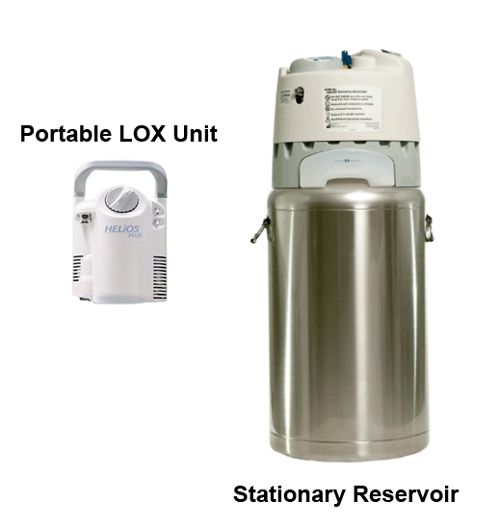
While liquid oxygen tanks provide many benefits over compressed oxygen tanks, they still cause a lot of inconveniences for oxygen patients. One of the most glaring problems with liquid oxygen tanks is that, in order to store oxygen in a liquid form, it needs to be kept at very low temperatures (typically around -183°C or -297°F). While the tanks themselves are designed to maintain these temperatures, it’s inevitable that the tank will heat up causing the water to evaporate over time. In other words, you won’t be able to store a liquid oxygen tank for a significant amount of time without the oxygen dissipating.
What is the Caire FreeStyle Comfort?
An oxygen concentrator performs the same function as a liquid oxygen tank by providing the user with medical-grade oxygen. The difference between the two, however, is that oxygen concentrators are electronic devices that run off of batteries. Rather than storing oxygen inside the machine, concentrators take ambient air, remove unneeded gases like nitrogen and argon, then puts out medical-grade oxygen through the nasal cannula.

The Caire FreeStyle Comfort is a pulse dose portable oxygen concentrator meaning it carefully monitors your breathing and only puts out oxygen when you need it. In other words, it conserves energy so that you can go more places and do more things on one battery charge. Much like a liquid oxygen cylinder, the Caire FreeStyle Comfort is very lightweight and easy to carry on your shoulder.
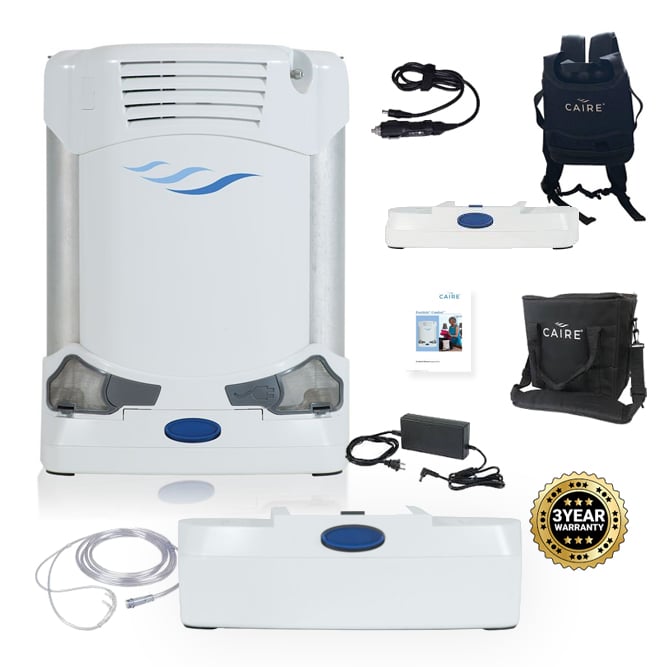
Another thing to note about this portable oxygen concentrator is that it’s manufactured by one of the most trusted brands in the medical oxygen industry. Caire Inc. advertises its products under the names SeQual, AirSep, and Caire, and the FreeStyle Comfort is one of their most advanced oxygen machines yet. Thee Caire FreeStyle Comfort is widely considered to be one of the best portable oxygen concentrators ever made, but many people also believe the Inogen One G5 is the best. Without further ado, let’s take a look at some of the reasons you should upgrade your liquid oxygen cylinder.
Safety
Safety is incredibly important. The reason for using supplemental oxygen therapy in the first place is to maintain oxygen levels in the blood and prevent life-threatening conditions like right-sided heart failure; so, it goes without saying that you don’t want your supplemental oxygen device to add any unnecessary health risks. And despite the fact that liquid oxygen tanks are safer than compressed oxygen tanks, they are still more dangerous to use than a portable oxygen concentrator.
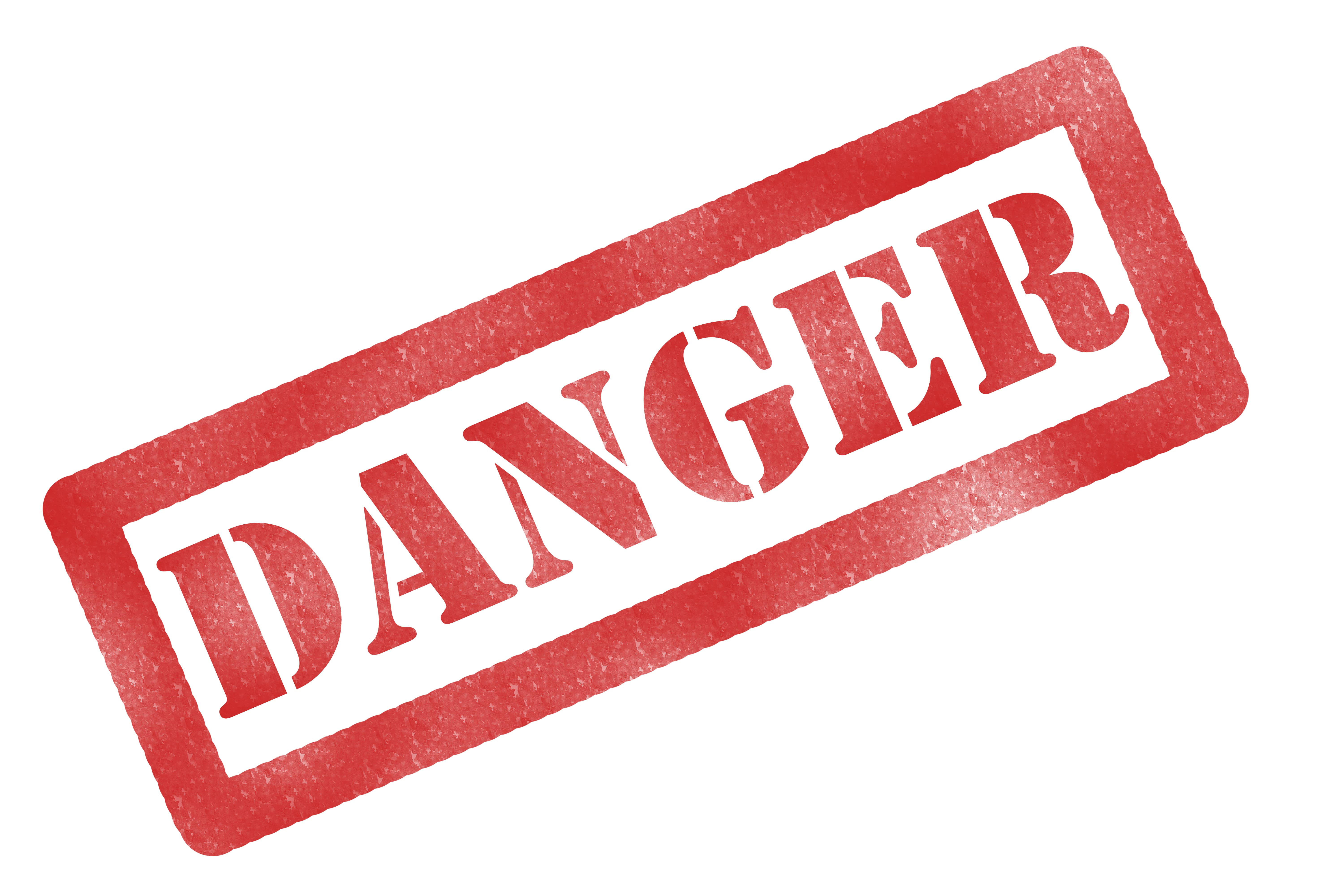
Liquid oxygen tanks are stored at a pressure of around 350 PSIG (pressure per square inch, gauge). While this is significantly less than the 2,000 psi that regular oxygen tanks are stored at, it can still be a safety concern. Liquid oxygen tanks have complex safety mechanisms in place that prevent pressure from building too high, but in reality, there is simply more that can go wrong with these units.
The great thing about portable oxygen concentrators like the Caire FreeStyle Comfort is that you never have to deal with a high-pressure device in the first place. Since oxygen concentrators take ambient air and immediately put it out of the nasal cannula, you never have to feel insecure about using supplemental oxygen. What’s more, if you happen to drop your nasal cannula the device will stop putting out oxygen until a breath is detected.
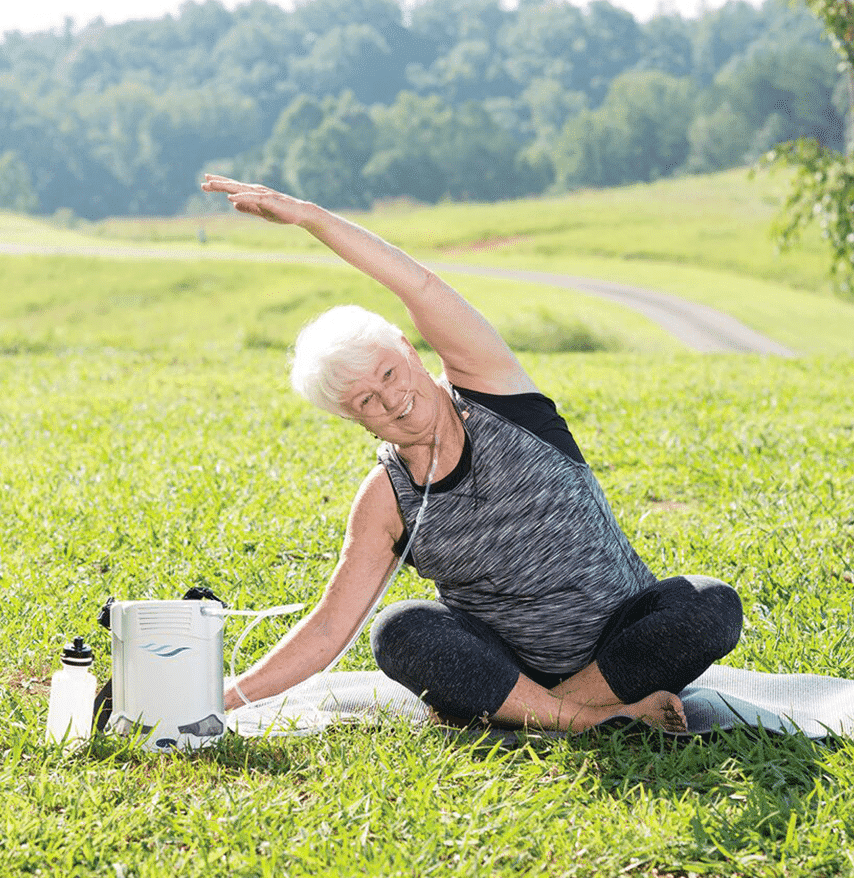
Convenience
Another point to note about traditional oxygen tanks and liquid oxygen tanks is that they’re extremely inconvenient to use. Because these tanks can’t be simply recharged like an oxygen concentrator, you have to have some way of refilling them. Whether that means having new tanks delivered by an oxygen company or having to refill them with a liquid oxygen reservoir, you’ll need to find something that works for you.
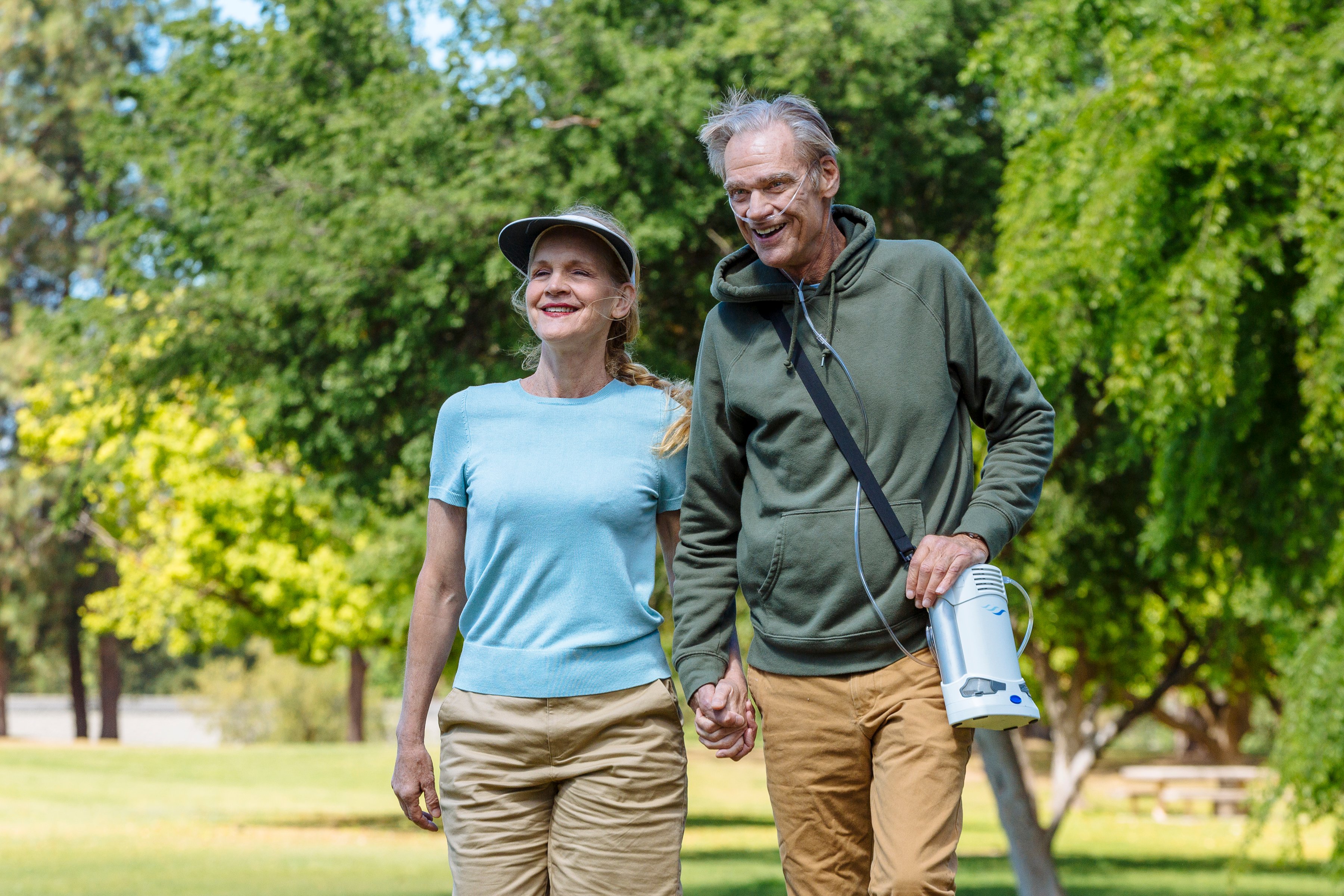
If you decide to have your tanks delivered or drive to an oxygen company to refill them, this could be a huge time sink for you and you may have trouble working your schedule around them. On the other hand, if you decide to purchase your own oxygen reservoir, you’ll only be able to refill your liquid oxygen tank in your home. On top of this, reservoirs tend to be very bulky, heavy, and difficult to move.
Since the Caire FreeStyle Comfort is charged through either a wall outlet or a car outlet, you’ll be able to take your portable oxygen concentrator just about anywhere with you. You’ll be able to charge your machine at your home, in hotels, airports, and in any vehicle that has a power outlet. And the best part of all is that you can use the machine while it’s charging, as long as it’s on a low flow setting.
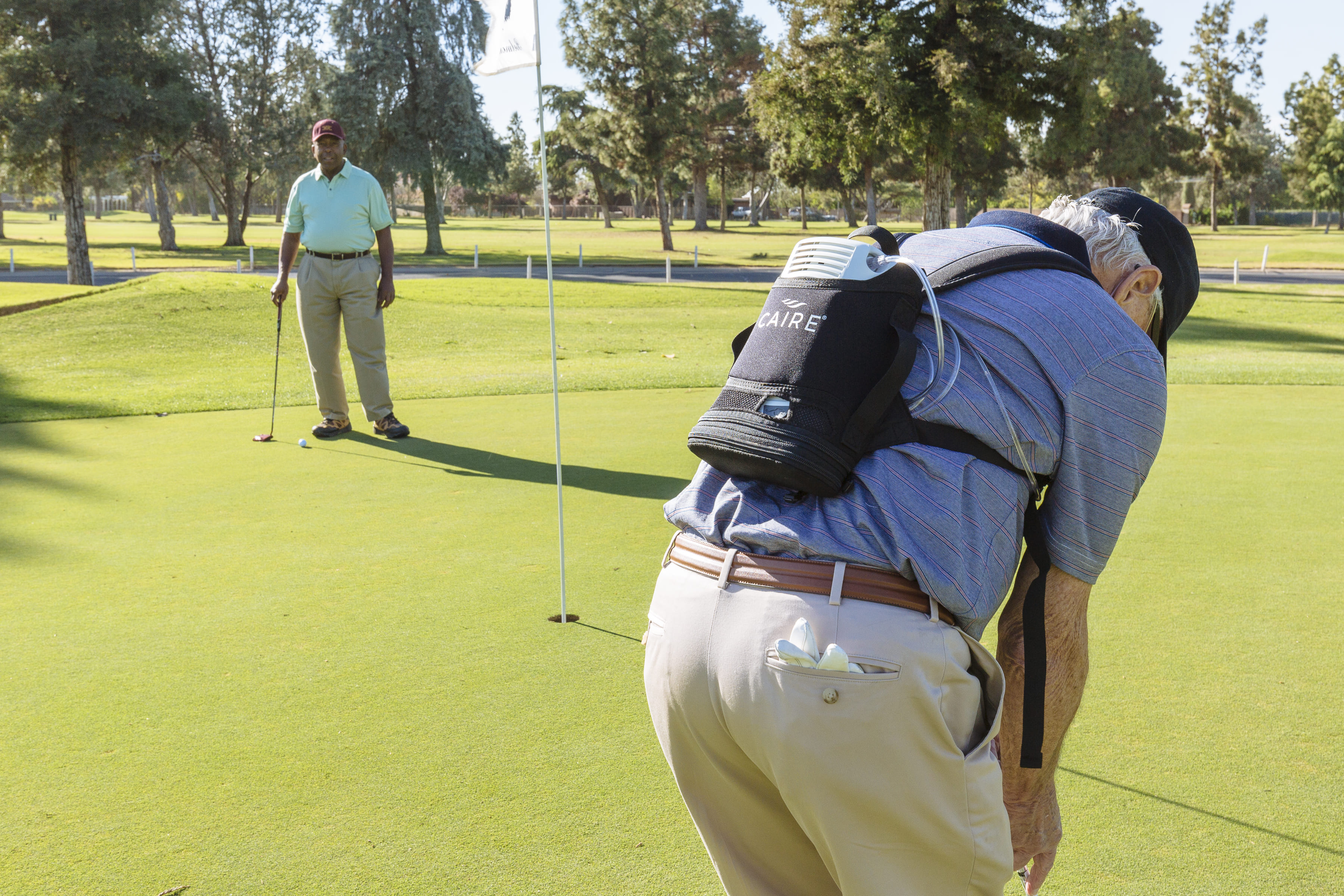
Long-Distance Travel
In the past, beginning supplemental oxygen therapy meant giving up your freedom to travel long distances. The Federal Aviation Administration (FAA) oversees safety regulations for commercial flights in the United States, and both traditional and liquid oxygen tanks are banned. What this means is that if you’re using one of these oxygen devices, you’ll be relegated to other slower forms of transportation.
However, the Caire FreeStyle Comfort — like most portable oxygen concentrators — is approved by the FAA for in-flight use. All you need to do is call your airline 48 hours ahead of your flight and be prepared to bring at least 1.5 times the duration of your flight in battery life. Once that’s out of the way, you’ll be able to fly anywhere in the country without question. If you’re going out of the country, be sure to check in with the regulations in your destination country before leaving.

Reliability
It’s easy to get caught up in talking about all of the other factors of a portable oxygen machine and forget about one of the most important factors: reliability. Having reliable supplemental oxygen means being able to be out and about at the store, visiting a friend, or on vacation, without ever having to worry about receiving the oxygen you need to maintain your blood oxygen levels. You’ll be able to spend more time focusing on enjoying your day and accomplish your goals rather than worrying about whether or not your oxygen needs are being met.
{{cta('43b79c5e-6bd6-4f02-ac27-2d038d20c146','justifycenter')}}
Like we mentioned earlier, liquid oxygen needs to be kept at very low temperatures in order to prevent it from turning into a gas. While liquid oxygen tanks are designed like a thermos to keep the internal temperature low, it’s inevitable that it will heat up over time, especially if you’re out in the hot sun. Over time, you will begin to lose oxygen from your liquid oxygen device even if you aren’t using it.

Portable oxygen concentrators like the Caire FreeStyle Comfort, on the other hand, are known for their reliability. In fact, back in August, we featured the FreeStyle Comfort as “the most reliable portable oxygen concentrator” ever produced. This is because it has the lowest failure rate of any POC on the market, meaning that, out of the box, it is less likely to have a defect than any other device like the Inogen One G5 or Respironics SimplyGo.
Another wonderful thing about the Caire FreeStyle Comfort — and portable oxygen concentrators in general — is that the vast majority of issues they have can be fixed on the fly. If you experience a glitch or the device isn’t working properly, a hard reset will typically fix the issue right away. We discuss how to perform a hard reset in this post, but if you have any problems either consult the user manual or reach out to our portable oxygen concentrator specialists at 1-(800) 946-1201.
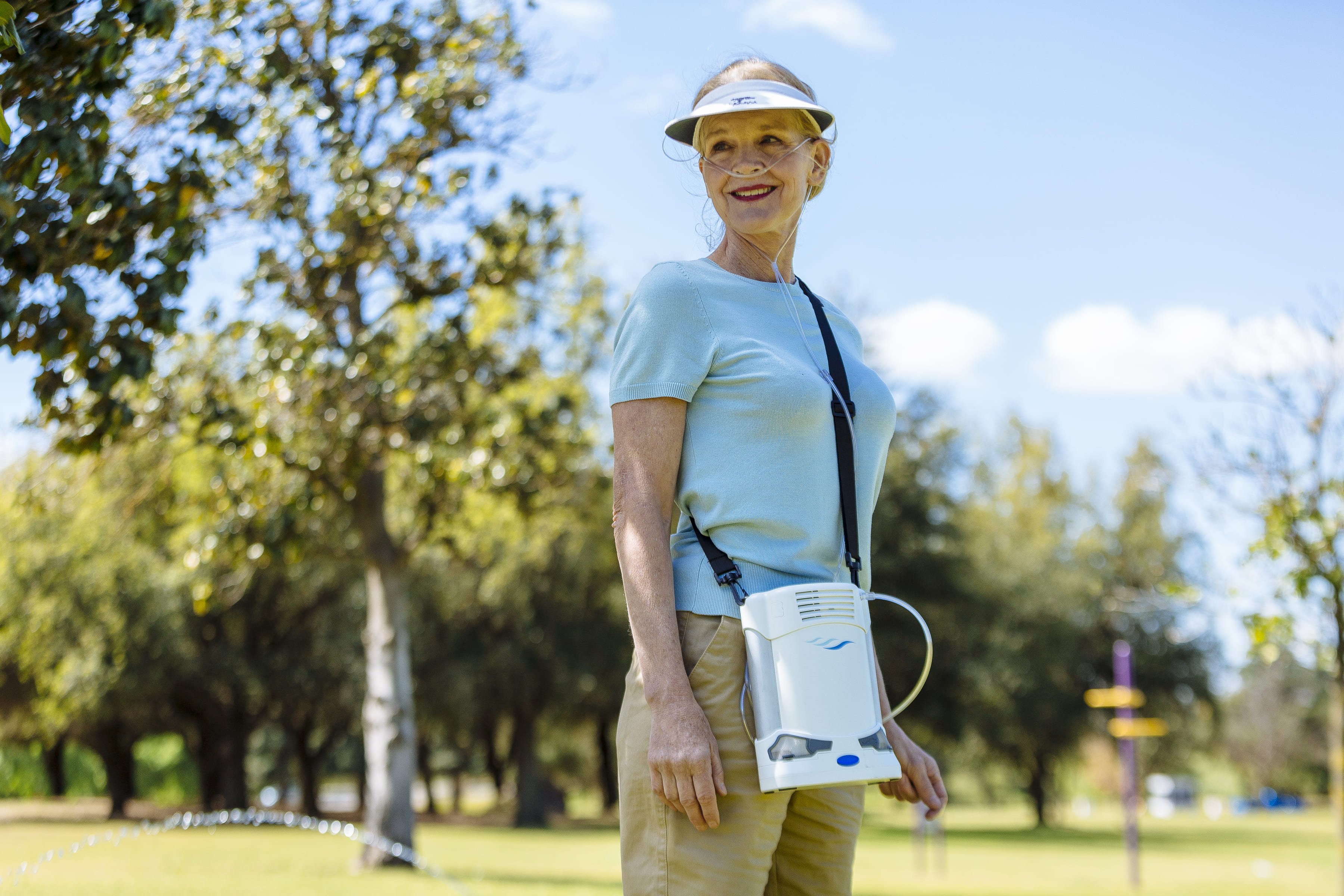
Liquid oxygen tanks are very different from this. Since they aren’t electronic devices like POCs, you can’t simply restart them if they aren’t working properly. Liquid oxygen tanks are a very complex piece of equipment, and if you tamper with them you risk injuring yourself or further damaging the unit. In order to fix your problem, you’ll need to send it to an oxygen specialist and it could take days or weeks to get it back.
Cost
Liquid oxygen is considered to be the most expensive form of oxygen therapy. Some of the more popular portable liquid oxygen units like the HELiOS Plus will run you over a thousand dollars. And remember, you’ll also need to either have a home fill reservoir to fill your own portable units or you’ll have to go to an oxygen supplier regularly. These costs can add up really quickly and there’s a lot more that could go wrong.
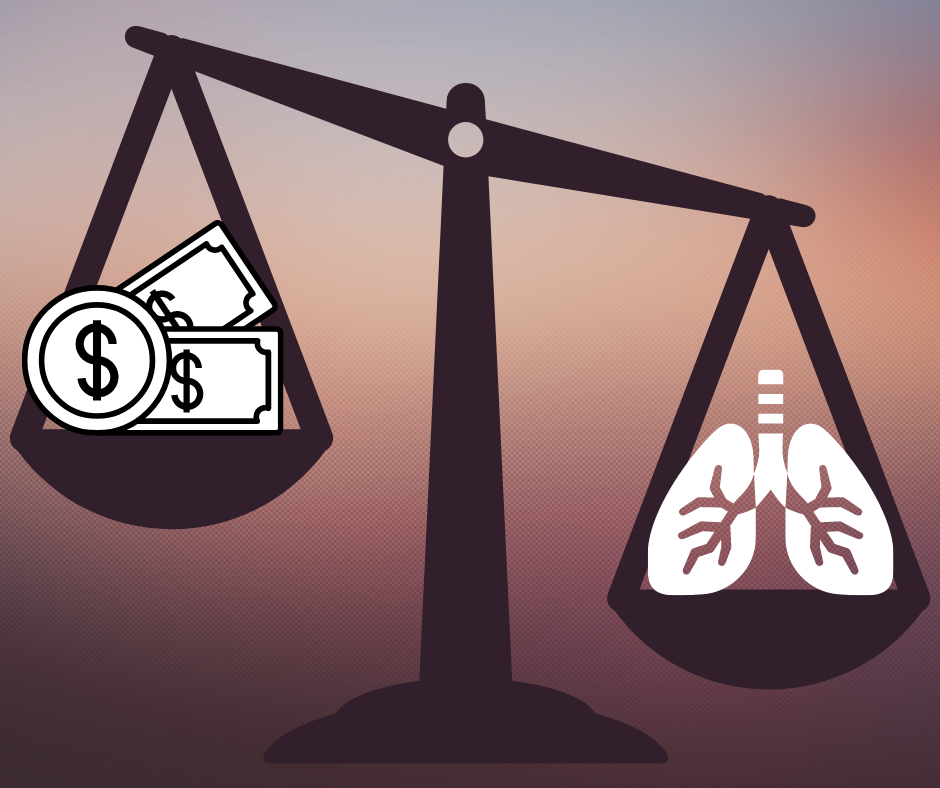
On the other hand, the Caire FreeStyle Comfort requires no additional components aside from the battery. Since these batteries are rechargeable, you won’t have to keep investing in your oxygen therapy over time. Simply plug your device into any wall or car outlet and you can charge the battery all the way up.
Ease-of-Use
Most people are very surprised to find just how easy it is to use the Caire FreeStyle Comfort. All you need to know how to do to get started is how to turn on the device, charge it, and adjust the flow settings. Any additional information about notifications, alarms, or warnings can be found in the user manual. However, with a liquid oxygen tank, not only will you need to know how to operate the portable unit, but you’ll also need to know how to refill it using the reservoir. This can be very time consuming and most people admit that it’s a pretty convoluted process.

Additional Features
The final reason to upgrade from liquid oxygen to the Caire FreeStyle Comfort is because of all the additional features you’ll get with the latter. The FreeStyle Comfort has something called CAIREview which is a free oxygen tracking application made by SynsorMed. By connecting your phone or computer to your POC, you’ll be able to see up-to-date information about your oxygen usage. Liquid oxygen tanks don’t offer any features like this.

Conclusion
Liquid oxygen tanks are a huge upgrade from traditional oxygen tanks. They’re lighter, smaller, safer, and hold a lot more oxygen. However, they offer few advantages over portable oxygen concentrators like the Caire FreeStyle Comfort. These oxygen machines enable you to have access to an infinite supply of oxygen no matter where you are in the world and they’re far more convenient and reliable than the alternative.
{{cta('fa8abc2a-1e88-4fa3-82fd-1cb5b9ed43b2','justifycenter')}}
Despite what you read here, we here at LPT Medical encourage oxygen patients to take their time when choosing a supplemental oxygen device. Also, it’s important to be open with your doctor and understand exactly what your oxygen requirements are. If you’d like to learn more about portable oxygen concentrators, don’t hesitate to reach out to our respiratory specialists. You can reach us at 1-800-946-1201 or you can email us at info@lptmedical.com.

Oxygen to be harnessed and used to treat respiratory patients is a relatively new form of medication, but it has been proven to increase the quality of life and even add years to people's lives with severe respiratory illnesses. As with any new treatment or medication, the tools and methods are evolving, becoming more advanced and efficient. The history of oxygen as a drug moves in an exponential trend towards the safest and most efficient devices that LPT Medical carries today.
As a modern day medical equipment company based in Denver, CO and other locations including Boca Raton, FL., we are humbled by the history of oxygen therapy products in particular. We want to appreciate all the pioneers and innovators who came before us, the ones who paved the way into a new-age of technology for people struggling with respiratory diseases.
Without their ingenuity we would not be here today, able to offer our customers these top of the line products like the Inogen One G5 and the Caire Freestyle Comfort. Oxygen has come a long way, and the methods in which oxygen is prescribed and the devices used to administer oxygen have both progressed into the safest and most effective products.
There was a moment in time where to pursue oxygen as a therapeutic resource for patients with chronic lung disease was cause for concern. In the 20th century of the risks of experiencing oxygen toxicity due to the administration of oxygen therapy was relatively high. Oxygen toxicity is a form of lung damage that occurs when you breathe in too much supplemental oxygen. It’s also called oxygen poisoning, and it happens to divers, people who use too much of their medical oxygen supply, or those who use supplemental oxygen and do not have low enough blood-oxygen levels.
{{cta('fa8abc2a-1e88-4fa3-82fd-1cb5b9ed43b2','justifycenter')}}
If you are using portable oxygen for long-term oxygen therapy purposes, your healthcare team will test you while you are doing normal activities or exercise and at rest to determine that your oxygen is at the correct setting. Talk with your doctor about how to use oxygen safely and correctly if you are unsure.

Similarly to any new medication or treatment, time and research was put into the application of oxygen as a drug, and overtime and with the accessibility of ambulatory oxygen devices, the long-term effects of continuous oxygen were able to be established and meet certain safety and efficiency requirements that we have today.
{{cta('43b79c5e-6bd6-4f02-ac27-2d038d20c146','justifycenter')}}
Today, there are three popular ways to get your oxygen outside of the hospital:
.
- Liquid oxygen tanks
- Compressed gas cylinders
- Portable oxygen concentrators
With a portable oxygen concentrator (POC) you will be able to carry this small, battery-powered device around with you, use it at home all day and night, and even take it with you on an airplane.

Your POC will come with a carrying case that you can throw around your shoulder if your device is light-weight enough to carry. You can also get a portable oxygen concentrator backpack that will carry your POC and other belongings. Other POCs come with wheels or a cart if they are 10 pounds or more like the Respironics SimplyGo and the Solar Eclipse 5. Both of these devices are continuous and pulse dose capable, offer high oxygen outputs, and they are still very portable.

POCs run on batteries, so a device with a larger battery will last longer, and you will never have to get the device “refilled” instead you will plug in the device or the battery to an external charger or an AC or DC outlet, and you can use the device while the batteries charges.
A liquid oxygen system has a refillable oxygen reservoir that is stationary inside your home and other smaller refillable portable tanks that you can take with you when you leave your home. The tanks are very cold, so you have to be careful when you handle them. Your delivery company will refill your tank about every 2 weeks, and you will refill your own portable tanks when you need to with the large reservoir in your home.
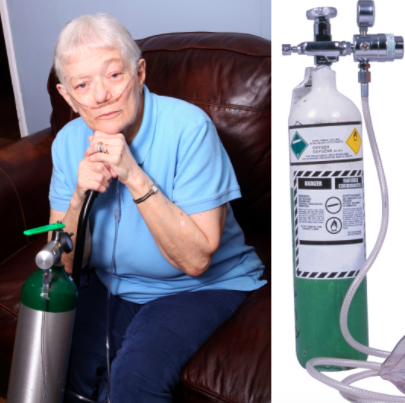
A compressed gas system can also be used at your home. It includes a stationary oxygen concentrator with a long tube. When you go out, you carry a portable tank. Your supplier can deliver the portable tanks to you refilled, or you can refill it on your own from your concentrator. When you go out with your portable tank, you’ll use an oxygen conserving device that supplies small, pulsed doses to help your portable tank last longer.
Based on this information, it might be evident that the portable oxygen concentrator is the newest and most efficient form of oxygen therapy that has been developed so far. Because the device takes air from the surrounding area, you will never have to rely on an oxygen supply company to come to your home and refill your oxygen, instead you just have to recharge the batteries as you would with your cell phone or other electronics.
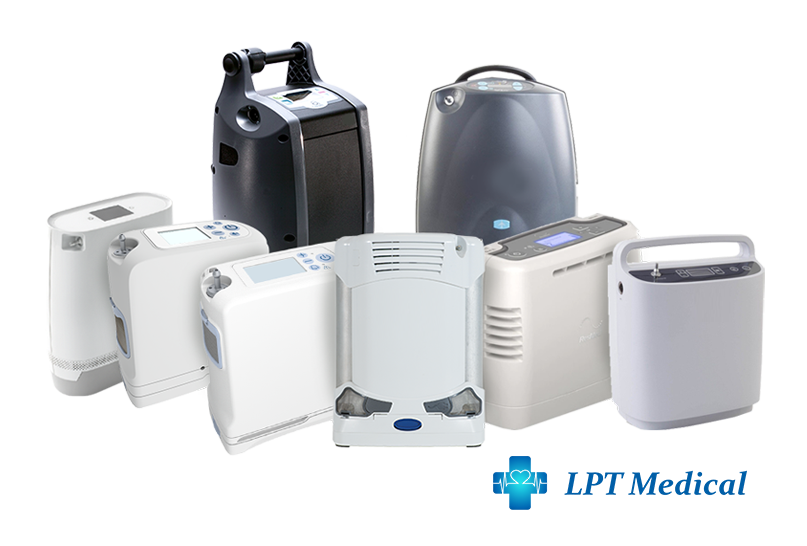
These devices are designed to be portable, so you can maintain a healthy and active lifestyle, even if you use your oxygen all day long. The pulse dose machines are typically under 6 pounds, making them easy to carry with you without getting worn out from the added weight.
The continuous flow devices range from 10-18 pounds, however these are still more portable and less restrictive than any other device like a tank or canister. The carts are durable, and the wheels are lightweight and large enough to make it through any kind of terrain. They also all fit underneath the seat in front of you when you fly, because one of the most freeing aspects of these devices is that you can fly on airplanes with them!
{{cta('b59df0c1-c4de-47a8-8e1c-0d33d4b414aa','justifycenter')}}
Before a portable oxygen concentrator, oxygen was still readily available to people with respiratory disease.
Here is the overall history of oxygen therapy:
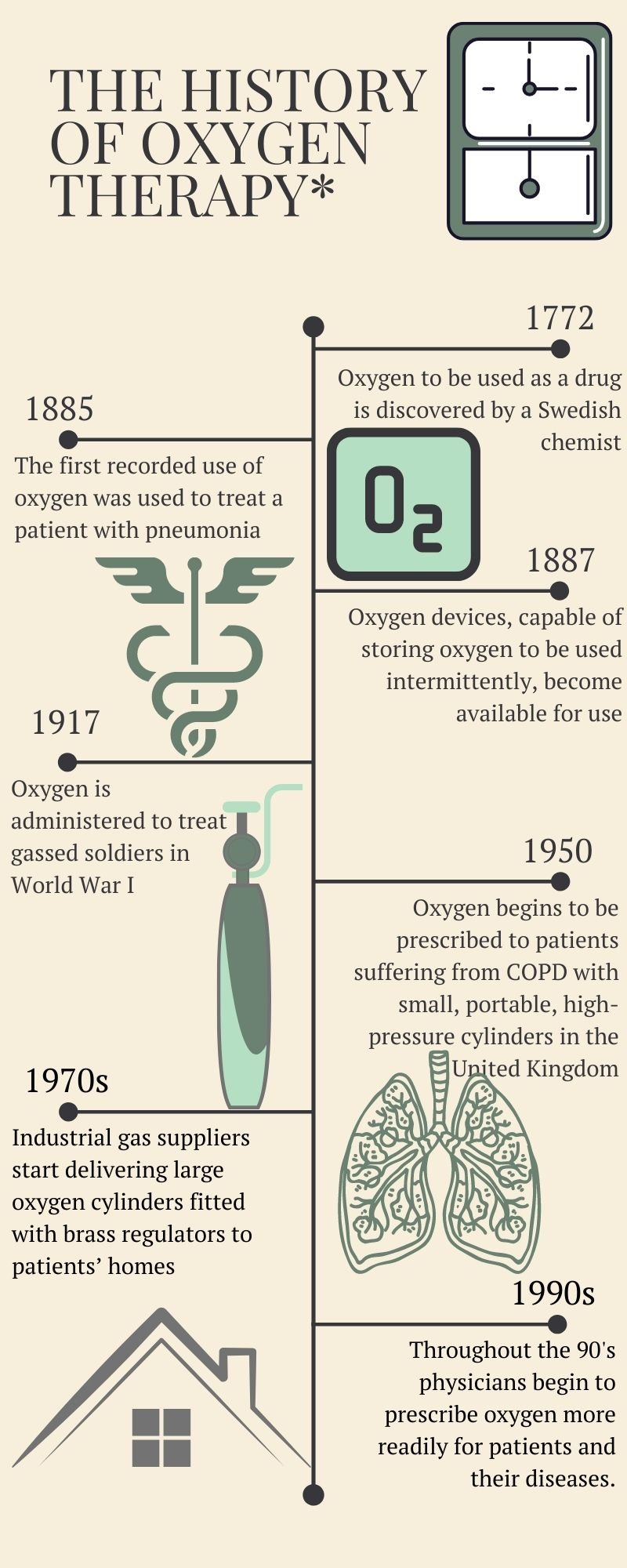
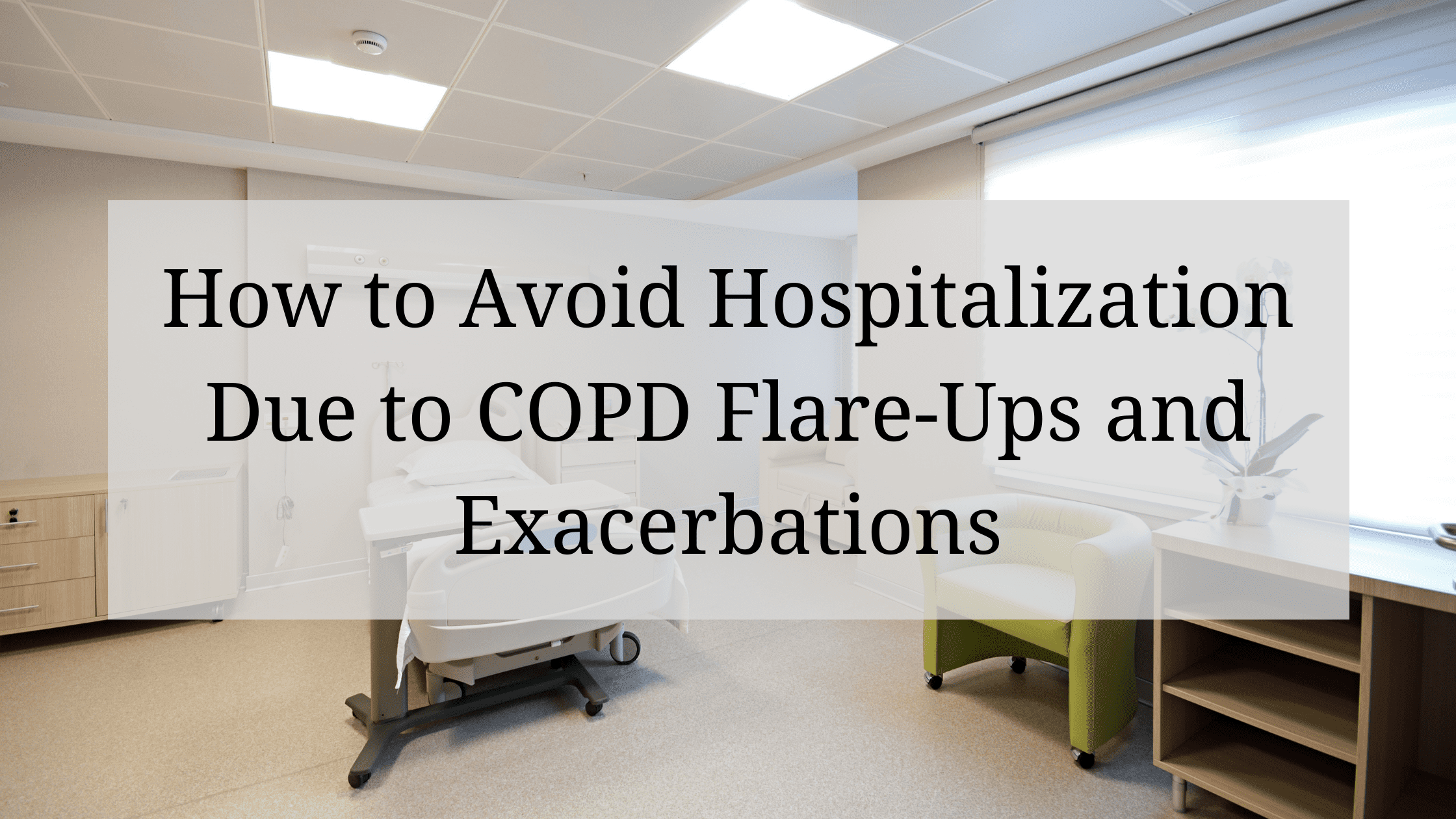
Chronic obstructive pulmonary disease (COPD) is one of the most common lung diseases in the world. It’s estimated that about 16.4 million people in the United States alone have COPD and millions more are either undiagnosed or at high risk of contracting it. Despite this fact, many people are woefully unaware of what causes this disease and how it should best be managed.
In short, COPD is an umbrella term that denotes two conditions: chronic bronchitis and emphysema. While the symptoms and pathogenesis of these two diseases are slightly different, they are both primarily caused by cigarette smoking. However, in rare instances, someone who has never smoked can contract COPD through something called alpha-1 antitrypsin deficiency (AAT deficiency).
One of the symptoms of COPD that’s particularly vicious is something called an exacerbation. This is similar to an asthma attack in that it causes respiratory symptoms such as breathlessness, chest pain, and sputum production to suddenly become worse, oftentimes requiring you to seek immediate medical attention. In this post, we will help you better understand COPD flare-ups and exacerbations, as well as how to avoid being hospitalized as a result.
If you have any questions or concerns, feel free to leave them in the comment section so we can address them.
{{cta('fa8abc2a-1e88-4fa3-82fd-1cb5b9ed43b2','justifycenter')}}
What’s the Difference Between a Flare-Up and an Exacerbation?
Generally speaking, the terms “COPD flare-up” and “COPD exacerbation” are used interchangeably. They both refer to respiratory symptoms becoming worse due to environmental causes, infections, or any number of other things. However, when it comes to discussing these symptoms, it’s important to be precise not only about what’s causing them but how severe they are as well.
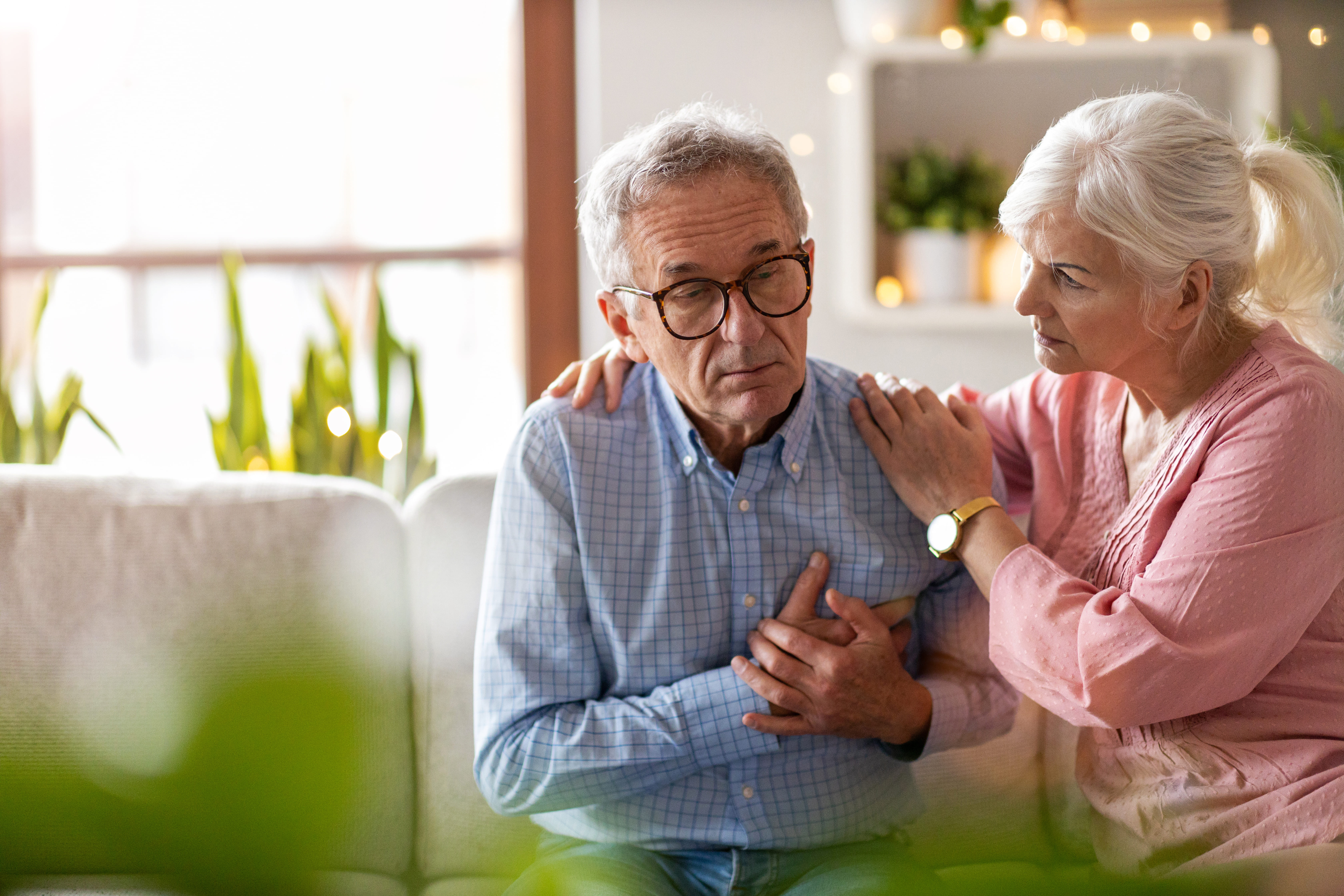
A mild COPD exacerbation is one that could lead to increased discomfort but is unlikely to cause any serious long-term consequences. These can typically be treated with short-acting bronchodilators (SABD) or “rescue inhalers” which work to quickly open up the airways allowing you to breathe better. Moderate COPD exacerbations should be supplemented with oral corticosteroids which suppress inflammation and antibiotics which can help fight inflammation.
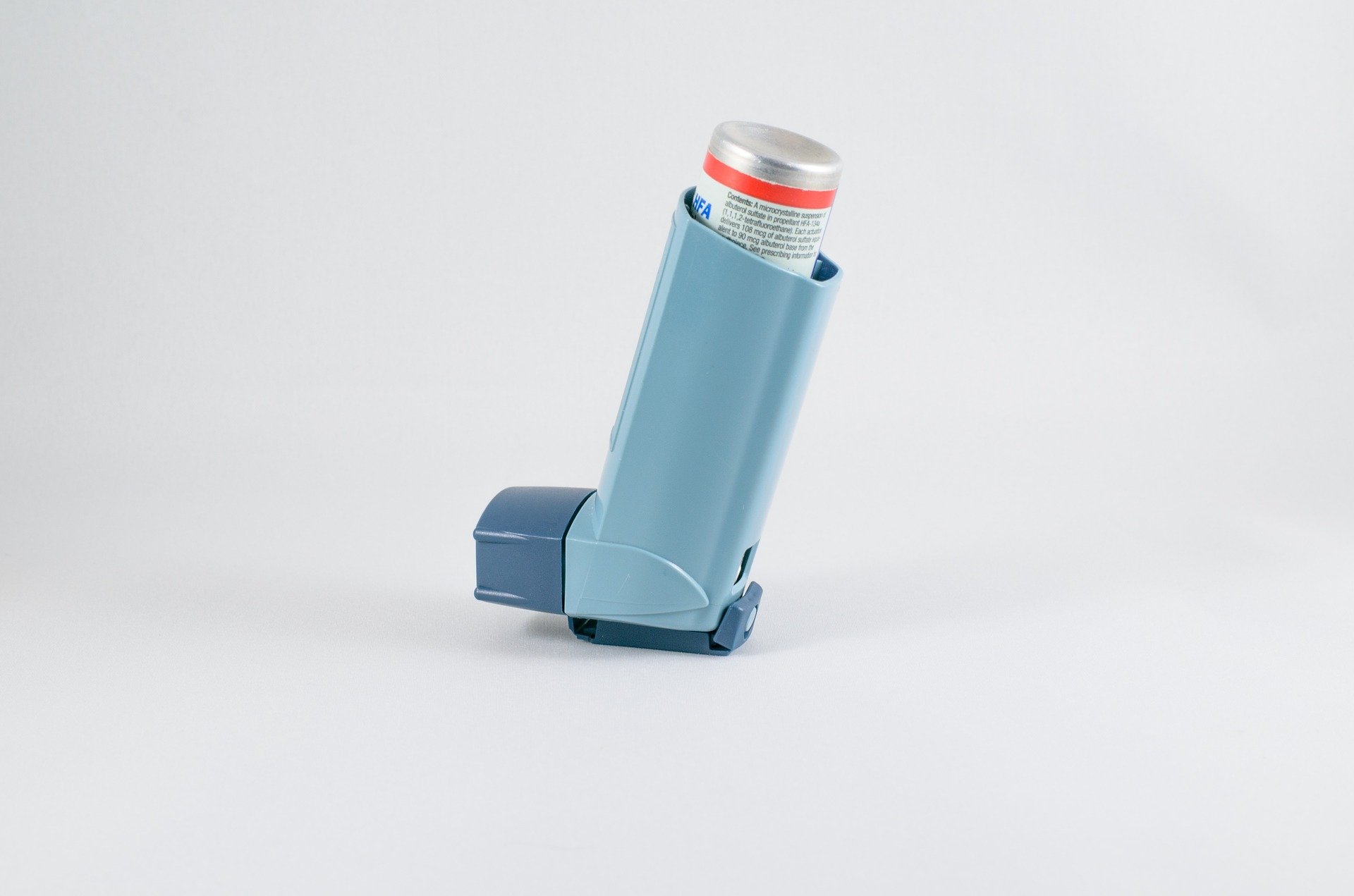
The final type of exacerbation is a severe exacerbation, sometimes called an “acute” exacerbation. This type of exacerbation requires immediate medical attention and can even be life-threatening if it’s not treated appropriately. Ideally, the best way to prepare for this type of exacerbation is to have an action plan and ensure you always have someone on hand to either take you to the hospital or call an ambulance.
Why it’s so Important to Avoid Hospitalization With COPD
According to the American Journal of Respiratory and Critical Care Medicine, COPD is responsible for $72 billion a year in direct healthcare expenditures. The majority of these costs come from hospital visits which range from 4.5 to 8.8 days on average. Around two-thirds of all COPD hospitalizations are due to COPD exacerbations, and the majority of COPD exacerbations are caused by infections — specifically viral infections.
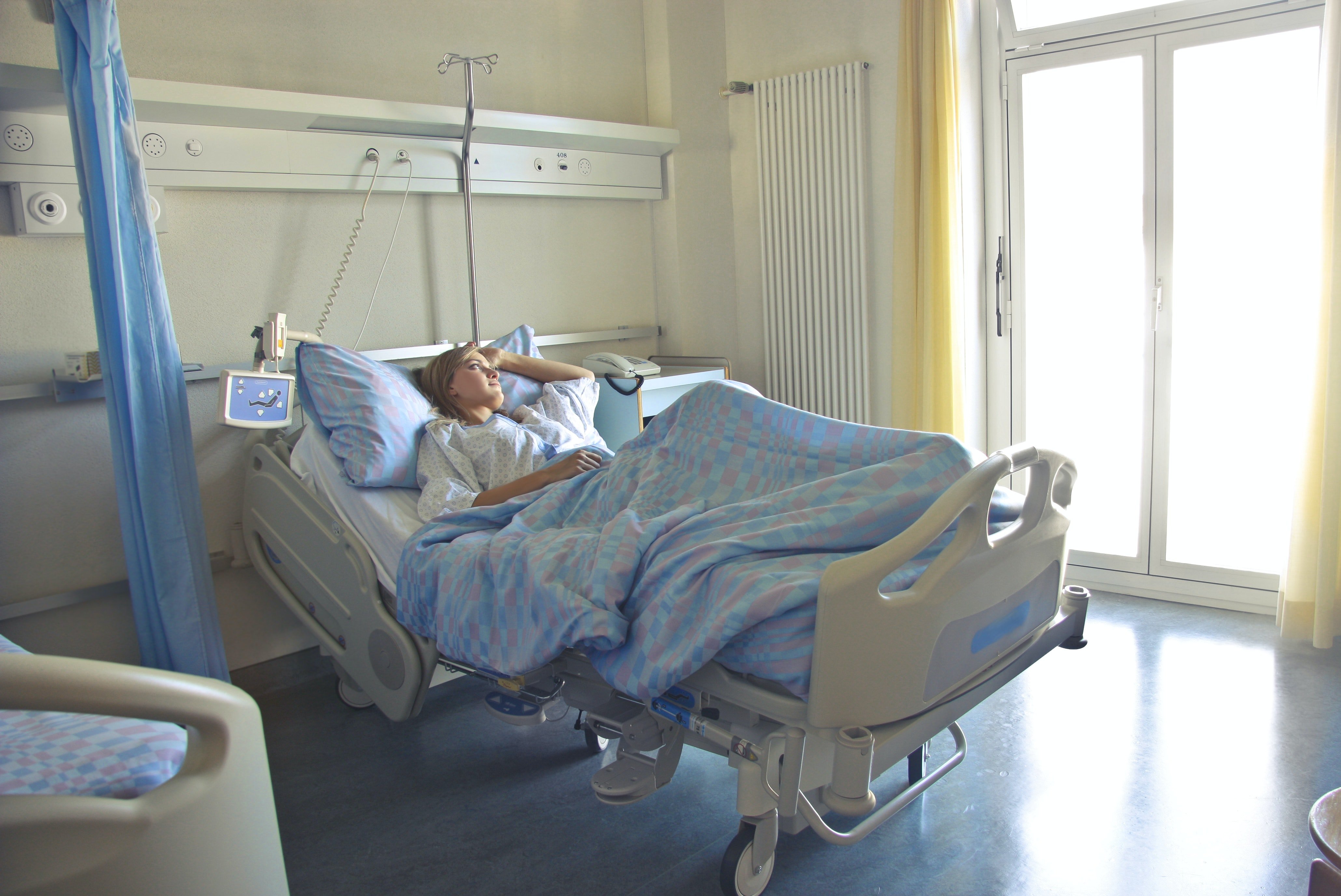
The primary reason it’s important to avoid hospitalization for COPD is because of the risks for your health. According to another study by the aforementioned medical journal, after testing over 2 million patients, the 1-year readmission rate was 64.2% and the 1-year mortality rate was 26.2% both of which were significantly higher than rates among the general COPD population. Readmission and mortality rates are also much higher among patients who were hospitalized with severe exacerbation of COPD.
The second most important reason to avoid hospitalization due to COPD is cost. Frequent or long-term admissions can pose a significant financial burden on people with COPD which can also lead to stress, anxiety, and even depression. In our last post, we highlighted some key ways that you can avoid unnecessary financial costs due to COPD so check it out if you’re interested in learning more.
Have a Plan to Deal With Exacerbations
First and foremost, if you want to avoid hospitalization due to COPD exacerbation, you need to have a plan of action before an emergency occurs. An action plan is a sort of written outline that you will follow in order to accomplish a certain goal. This way, if you notice your COPD symptoms starting to worsen, you can refer to your sheet instead of worrying about making difficult decisions at the moment.

In order to prepare your COPD action plan, you should first consult your doctor. He/she will likely already have a template that you can fill out to make this process a little easier. On this action plan, you will need to create an “action” for every symptom you experience. For example, if the symptom is a gradual decrease in your blood oxygen levels, you might make a note to increase your oxygen flow setting or contact your doctor. If you experience sudden shortness of breath, you might make a note to use your rescue inhaler.
Another important thing to know about your COPD action plan is that it should not be private information. You should make it a priority to go over your plan with friends and family, especially if they spend a lot of time with you. This way, if you are in a situation where you are unable to act out your action plan, they will be able to help. In this post, we discuss how you can prepare for medical emergencies and hospital visits with COPD, so check it out if you want to know more.
![]()
Change Up Your Diet
Diet can be a very difficult topic to discuss in this day and age. Most people have access to more types of food than ever before and there is a near endless list of diets that people swear by. As a result, it can feel like an insurmountable task trying to find something that keeps you happy and healthy. The good news, however, is that many years of research have been dedicated to COPD diets, so you shouldn’t have to do much scrambling to make sense of it all.
![]()
Generally speaking, COPD patients should maintain a diet that’s high in protein, fiber, and fat, but low in carbohydrates. The reason for this is that the metabolism of carbs produces the highest amount of carbon dioxide in the body while the metabolism of fat produces the least. Adequate protein ensures your respiratory muscles stay strong and efficient, and fiber helps to control blood glucose levels and reduce cholesterol in the blood.
Another reason to keep your diet healthy, natural foods rather than processed ones is because weight management is vital to COPD management. Most often, people tend to become underweight after contracting COPD due to a loss of appetite or other factors. Sometimes, people experience a loss of appetite because consuming food is more physically exerting than it was previously, and bloating can contribute to breathing difficulties. COPD patients who are underweight may find that they lack the energy or endurance to make it through the day.

On the other hand, being overweight with COPD can contribute to breathing problems as well. While it is less common for a COPD patient to become overweight than underweight, the problems associated with it can be just as severe. Simply put, having a higher body mass index (BMI) can be obstructive to your breathing by putting more strain on your lungs when you inhale. However, some studies have found mixed results when it comes to being overweight/obese with COPD.
Be Consistent With Your Exercise Routine
Consistency is unbelievably important when it comes to treating COPD and preventing exacerbations. For example, your diet is much more likely to benefit you if you keep up with your goals week in and week out. But if you do well one week then cheat the next, you’re going to put yourself at a much higher risk of COPD complications like exacerbations. This works pretty much the same way when it comes to your exercise routine.
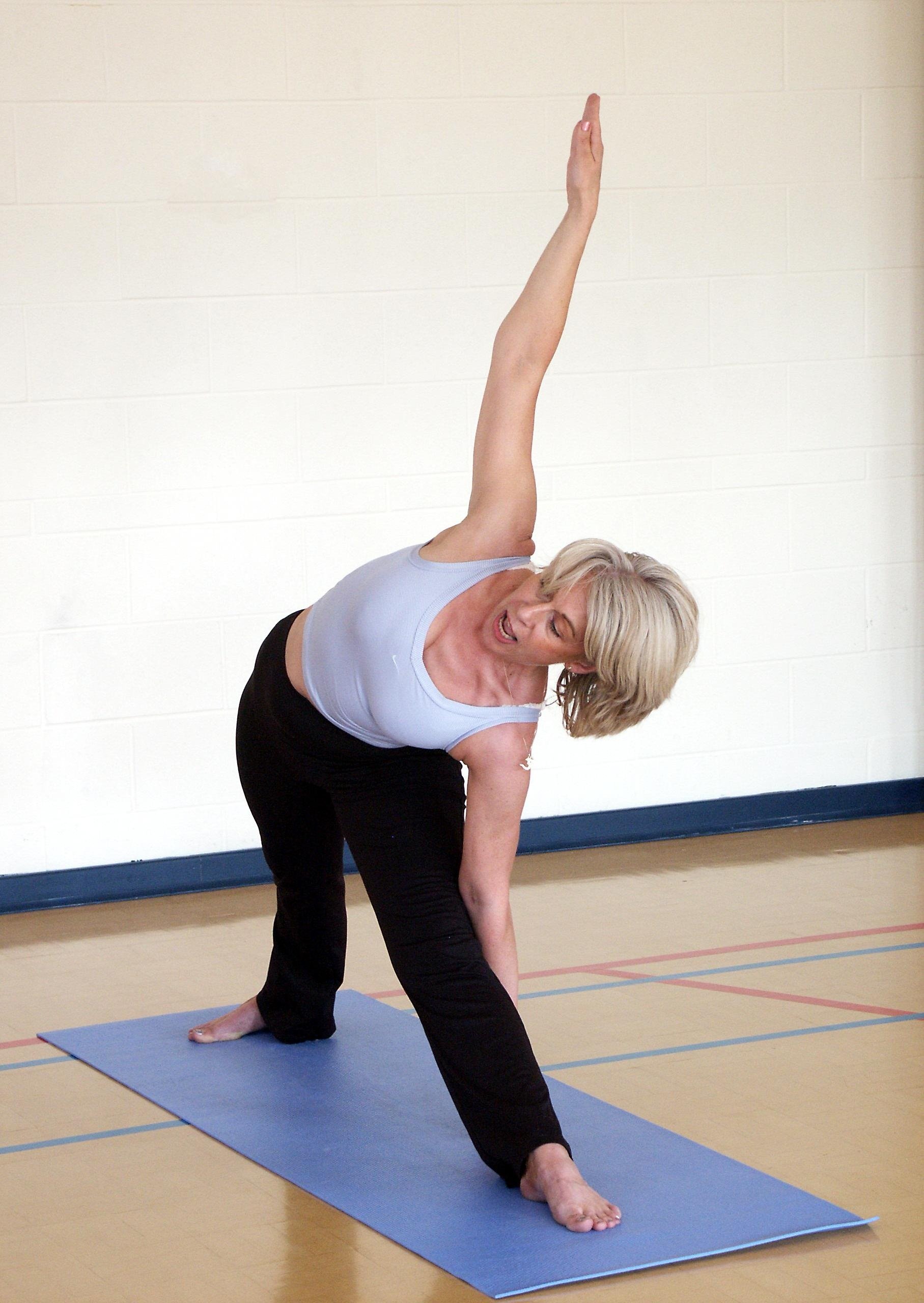
Oftentimes, exercise specialists will talk about getting into a “routine.” In other words, you do the same exercise each day for an allotted period of time. By doing so, it will be much easier to track your progress and catch yourself when you fall back on your plan. This works well for most people who want to commit to an exercise routine, but it’s especially useful for COPD patients who benefit more from consistent moderate exercise rather than high-intensity exercise.
Avoid Getting Sick
Lung infection is both the number one cause of severe COPD exacerbation and the number one cause of hospitalization due to COPD. With that being said, staying healthy and avoiding infection (especially lung infections) is vital. One of the best things you can do right now to avoid getting sick is to quit smoking or avoid second-hand smoke if you live around smokers.
It’s been known for quite some time that smoking reduces the immune response in the body and also makes the smoker more likely to have exaggerated responses to viral infections. During influenza outbreaks and with the current situation we face involving COVID-19, smokers have a much lower survival rate when compared to the general population. Not to mention that smoking and second-hand smoke can trigger COPD exacerbations even if an infection isn’t present.
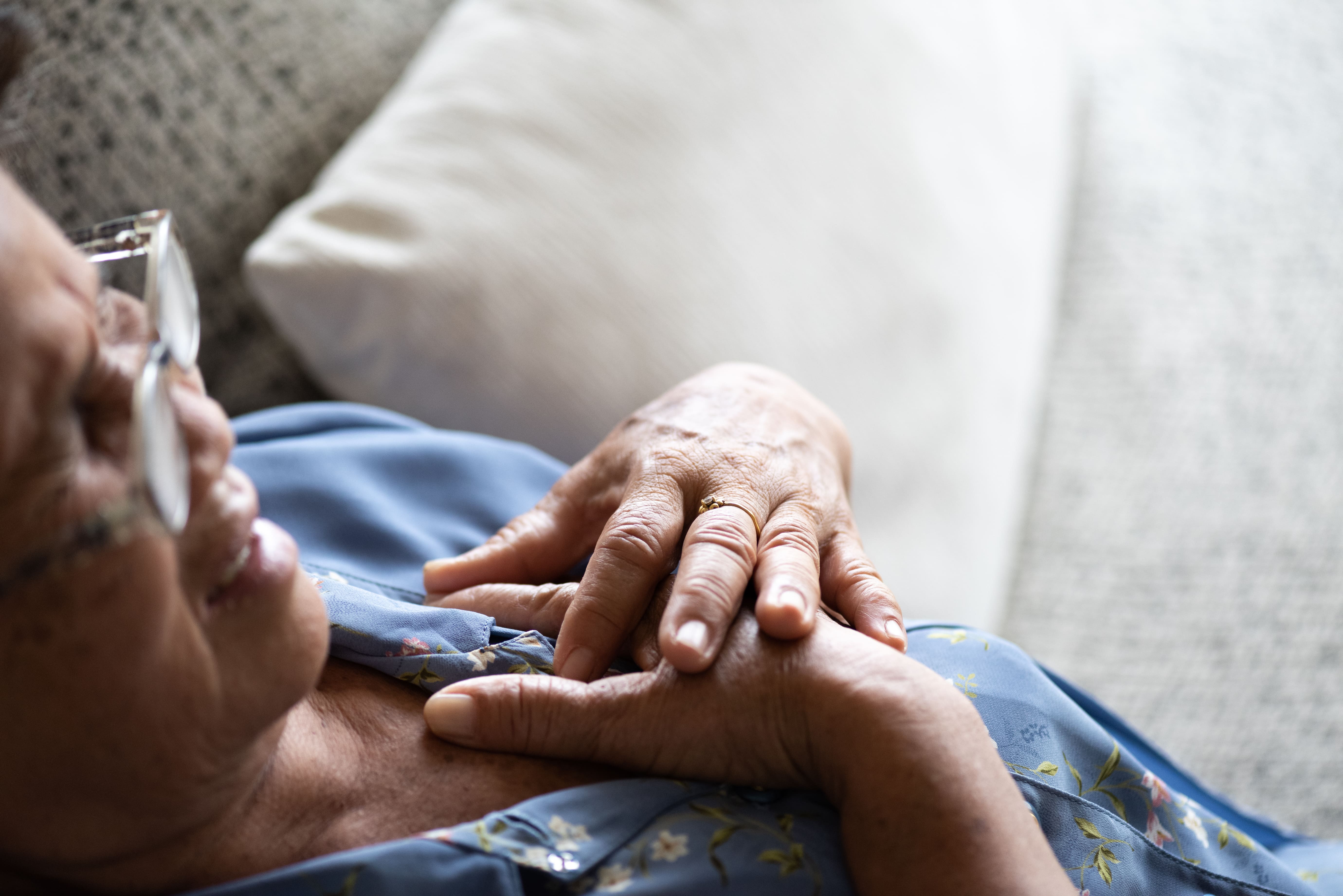
Another thing you can do to avoid getting sick is to be more conscious of your daily habits. For example, do you wash your hands frequently throughout the day? Do you take care to avoid places that are unclean or unsanitary? Do you stay away from people who exhibit symptoms of the cold or the flu? Do you clean surfaces in your home like door handles, coffee pot handles, or faucet handles? Are you following all the precautions recommended by the World Health Organization (WHO) in order to prevent contracting the novel coronavirus?
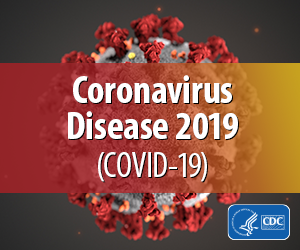
Last but certainly not least, you should be getting the doctor-recommended eight hours of sleep each night in order to avoid getting sick. According to WebMD, sleep deprivation suppresses the immune system and puts you at a higher risk of contracting colds, the flu, and other ailments. This is an especially difficult topic for many COPD patients because respiratory symptoms can make it difficult to maintain a healthy sleep schedule. In this post, we take a look at some actionable tips to improve your sleep if you have COPD.
Avoid Environmental Triggers
It can be a scary world out there for anyone who values their lung health. From wildfire smoke to car exhaust and pollen, it’s easy to feel like no place is safe. The Environmental Protection Agency (EPA) even reports that indoor air can be two to five times more polluted than outdoor air. Fortunately, it’s not all grim news for COPD patients who want to avoid exacerbation triggers. Just by following a few simple steps, you’ll be well on your way to avoiding the most common triggers.

Despite summer ending last week, we are still in the midst of wildfire season. As a result, COPD patients need to be aware of when they go outside, especially when it concerns exercising outdoors. Air quality index (AQI) is the measurement we use to determine how safe outdoor air is to breathe. Each day before you go outside, be sure to check AirNow.gov for the AQI in your area. If the AQI is above 100, this is a sign that the air quality is too poor for people with lung diseases like COPD, asthma, or pulmonary fibrosis.
Another thing you should be wary of is seasonal allergies. Contrary to popular belief, allergies are a reality during all times of the year as opposed to only being active during certain seasons. In September and October, allergens like ragweed are typically at their peak. According to WebMD, if you get allergies in the spring, you are about 75% likely to have reactions to ragweed. So, if you’re outside this trying to enjoy the fall colors and cool weather this year, just be aware that allergies are still a reality.

The final airborne COPD exacerbation triggers we’d like to talk about are the ones found in your home. Like we mentioned earlier, indoor air can potentially be more dangerous than outdoor air. This is because the air in your home is extremely concentrated, so if you track things in like dust, allergens, or smoke, it will likely start to build up in one area of your home unless you take the time to clean regularly. While it may not seem that important, taking the time to vacuum, dust, and wipe down surfaces every day can go a long way to preventing COPD exacerbations. What’s more, it will help you get your daily exercise.
Use a Reliable Portable Oxygen Machine
Last but certainly not least, having a reliable portable oxygen device that you can take anywhere will put you in the best position to avoid COPD exacerbations and hospitalization. For the vast majority of COPD patients, supplemental oxygen therapy is a medical necessity. Not only does it stabilize your lung condition, but it also ensures your blood oxygen levels are normal, which in turn saturates every organ in your body with the oxygen it needs to function properly.
{{cta('b59df0c1-c4de-47a8-8e1c-0d33d4b414aa','justifycenter')}}
For the foreseeable future, portable oxygen concentrators are your best bet for reliable portable oxygen. Unlike oxygen tanks or liquid oxygen tanks, portable oxygen concentrators are electronic devices. So, instead of having to go out of your way constantly to have your tanks refilled by an oxygen specialist, you simply need to carry batteries with you. Fortunately, these batteries are lightweight and don’t take up very much space in your backpack or handbag.
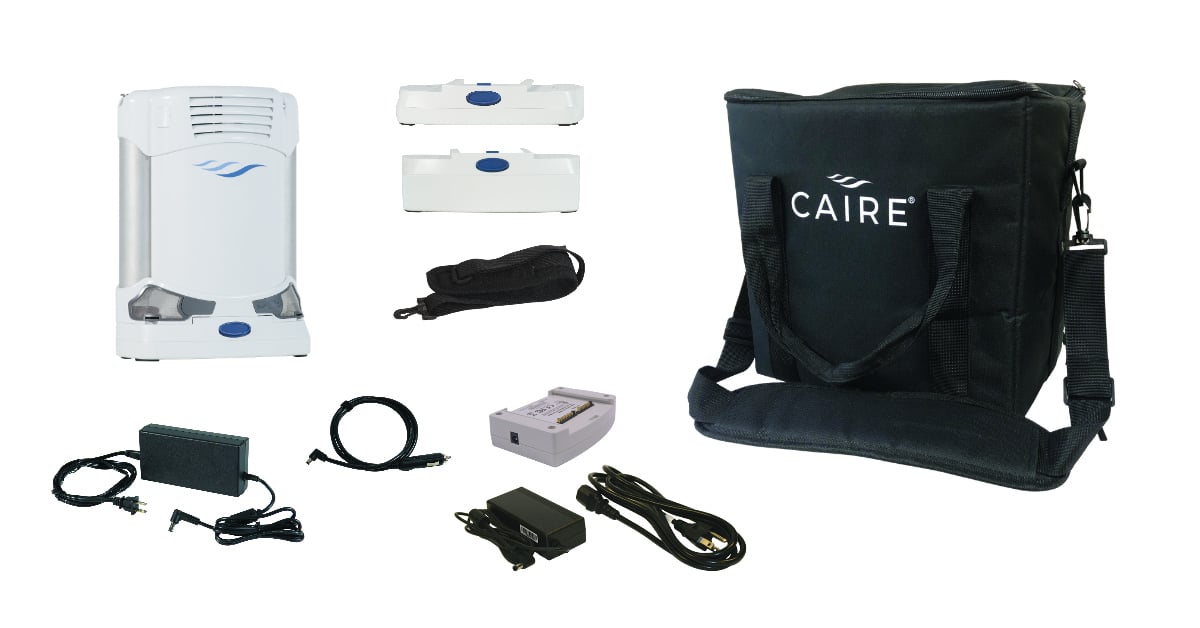
Currently, the best portable oxygen concentrator on the market is the Caire FreeStyle Comfort. It weighs in at only 5 pounds and it offers 5 different flow settings that you can adjust on the fly as needed. One of the unique features of the FreeStyle Comfort is its ergonomic design which keeps the device comfortably at your side rather than jostling around as some other concentrators do.
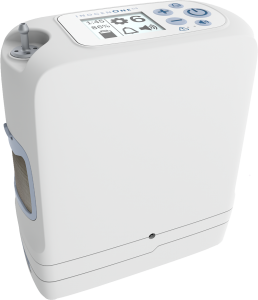
Another portable oxygen concentrator we’d like to recommend is the Inogen One G5. While this POC came out last year, it’s still very relevant and a great choice for anyone who needs a reliable 24/7 medical oxygen supply. The Inogen One G5 has one more pulse flow setting than the FreeStyle Comfort and it weighs slightly less at just 4.7 pounds. Inogen is one of the top brands in the medical oxygen industry and they take pride in customer satisfaction.
In rare instances, your doctor may require you to use a continuous flow concentrator. If this is the case, we recommend the Respironics SimplyGo portable oxygen concentrator. This unit is twice as heavy as the Caire FreeStyle Comfort, but since it puts out a continuous flow of oxygen, it can be used with your CPAP or BiPAP machine if you have sleep apnea or another related sleeping disorder. If you’re looking for affordable portable oxygen concentrators, don’t hesitate to visit our online oxygen store.

Conclusion
Unfortunately, exacerbations and flare-ups are a reality for COPD patients. But that doesn’t mean that you can’t take steps to reduce your risk of experiencing hospitalization due to an exacerbation. Above all, following your treatment plan as closely as possible and preventing sickness like the cold or flu will be your best bet if you want to avoid hospital visits.
If you would like to learn more about managing chronic respiratory conditions such as COPD, stay tuned to our blog. We aim to equip our readers with the knowledge they need to combat breathlessness, chest pain, and fatigue in their daily lives, as well as learning how to cope with the mental aspects of chronic disease like anxiety and depression. Feel free to leave a comment below if you have any questions or concerns.
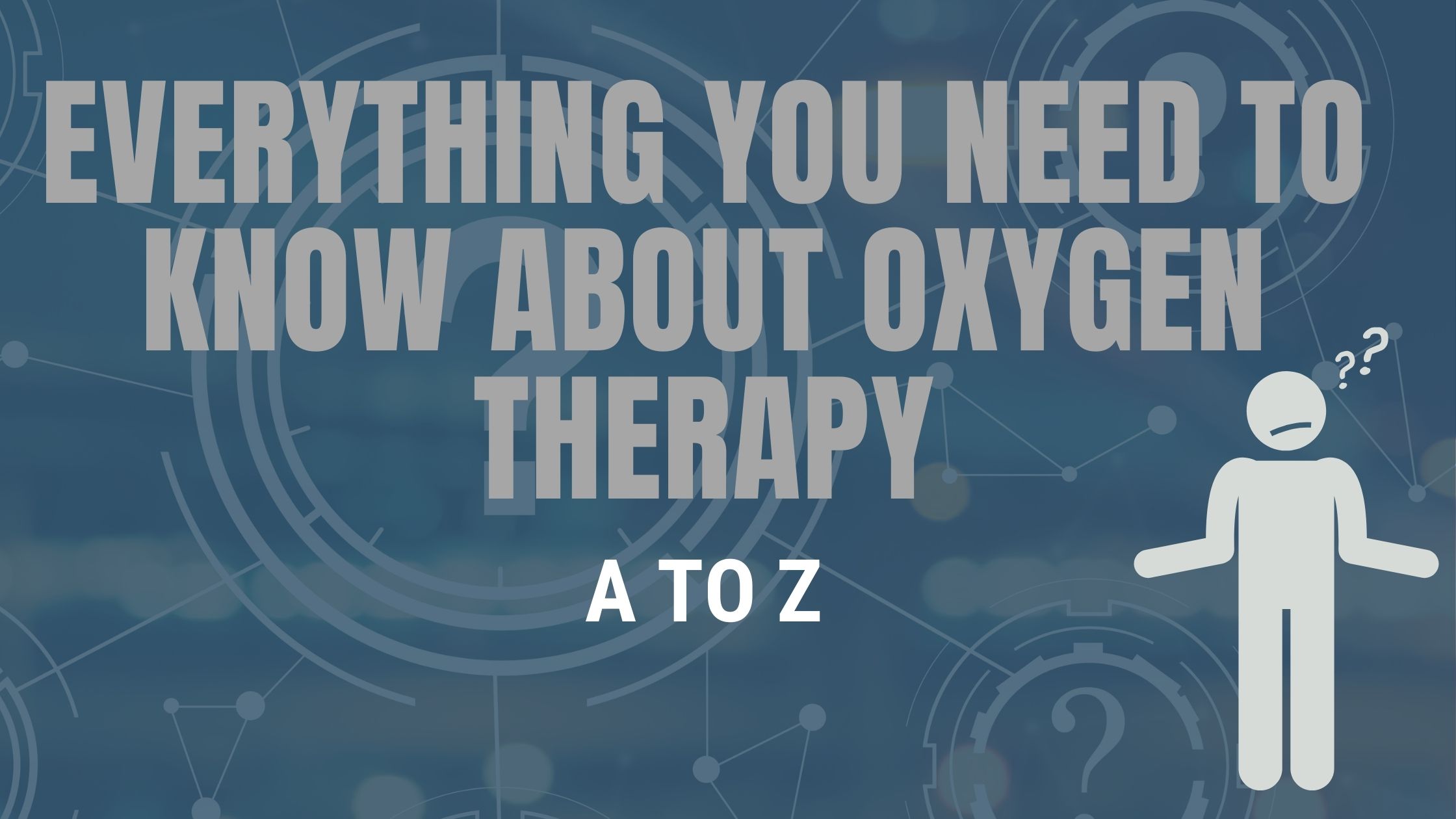
Oxygen therapy has evolved to the point where the oxygen user should not only be getting the oxygen they need to breathe, but the freedom and independence to do more activities, travel, and find happiness in everyday comforts. The demand for oxygen to be user friendly, portable, and noninvasive is hugely due to the fact that every year, about 1.5 million patients in the United States utilize long term oxygen therapy.
However, not every oxygen device can give patients the freedom they deserve. In fact, many oxygen devices tether its user to their home, making travel impossible and exercise unbearable. We are lucky enough to live in an age of innovation and growth, oxygen therapy is no exception. The technology that is used to design and manufacture modern oxygen devices has improved drastically and has come a long way from the heavy and bulky oxygen reservoirs used in the past.
{{cta('fa8abc2a-1e88-4fa3-82fd-1cb5b9ed43b2','justifycenter')}}
Shopping for oxygen
It is important to note, that with the growth and demand for new forms of oxygen technology, came a lot of cheaply made replicas and non-licensed distributors selling malfunctioning oxygen machines. It is important for people shopping for oxygen therapy devices to speak with their doctors and find the most trusted oxygen brands and suppliers that they can work with.
If you are looking into buying your first or a new oxygen device, it is not only important to do your research, but you also should not go with the cheapest option you find on Google. Your oxygen device is going to be your trusty companion all day and all night for the rest of your life, so making sure you get the right device for your oxygen needs that also fits into your lifestyle is essential for your wellbeing.
In this article we talk about a number of aspects surrounding oxygen therapy:
- We look at the evolution of oxygen
- Understanding flow rates
- We will go over your oxygen therapy options
- We will give you a list of the most trusted names in oxygen manufacturing companies
- We will discuss our best selling portable oxygen concentrators
- How to make the most of your oxygen therapy
Evolution of Oxygen Devices
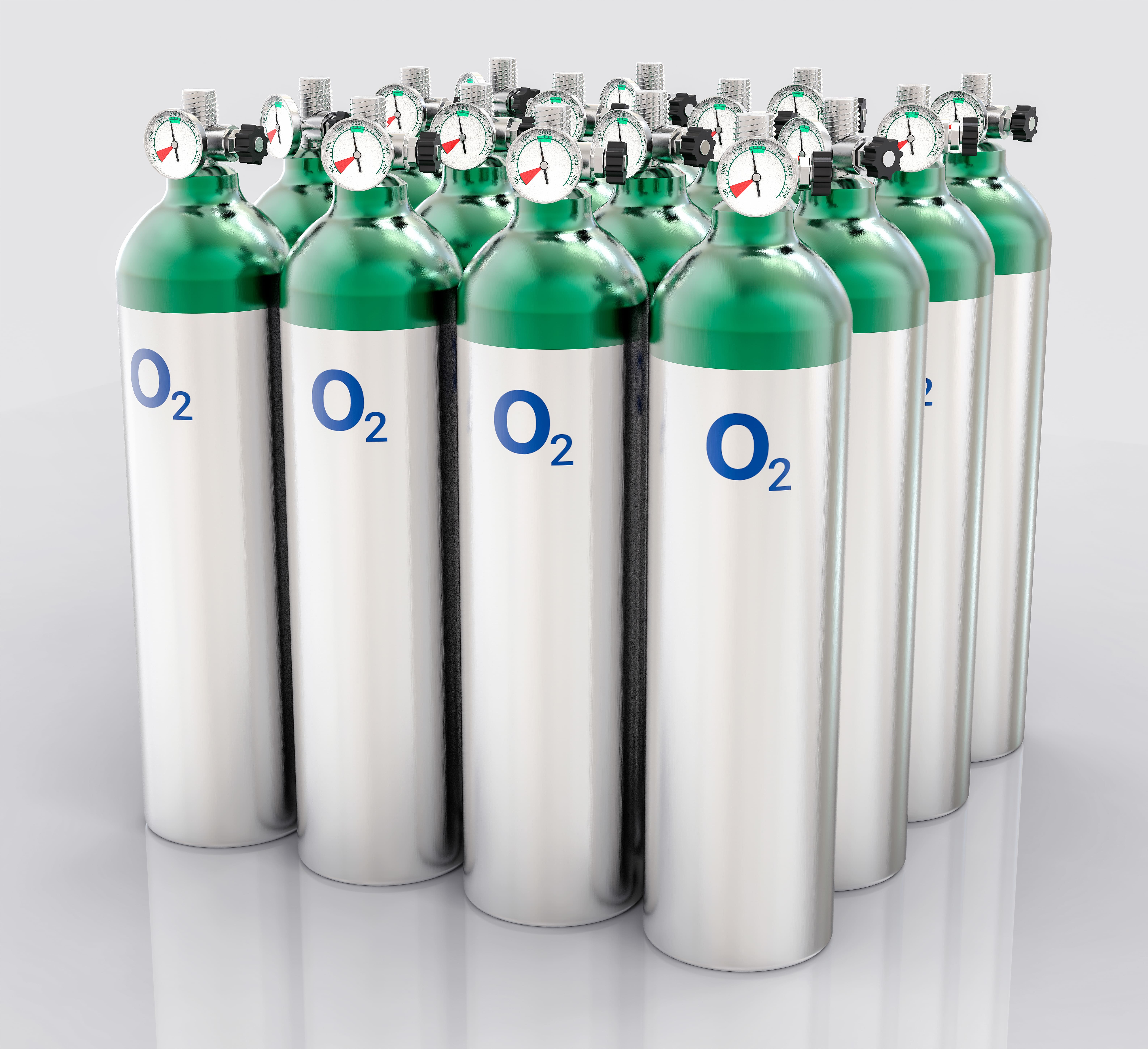
Long term oxygen therapy (LTOT) is prescribed to patients with chronic obstructive pulmonary disease (COPD) and other chronic lung diseases. LTOT increases survival and improves the quality of life of users with hypoxia, it can be very dangerous if used incorrectly, which is why oxygen is prescribed to patients by their doctors after taking a series of pulmonary function tests.
In the beginning, pressurized cylinders were the only available option for long term oxygen therapy. Then in 1965, the first home based liquid oxygen system was invented which gave the oxygen user both an immobile and portable oxygen system. This presented a great advantage, where the oxygen user finally had the ability to refill their portable liquid oxygen system and their smaller portable system whenever needed.
In 1973 home oxygen concentrators became readily available, these devices operated by filtering nitrogen from the air and producing medical grade oxygen. Oxygen concentrators provided an unlimited supply of oxygen, and it ran off of electricity. While this oxygen system was safe and efficient it was stationary, and tethered its users to their home where there was electricity.
Today, there are combinations of oxygen devices:
- Compressed gas canisters
- Liquid oxygen tanks
- Concentrators
- Liquid oxygen portable canisters
- Battery operated portable oxygen concentrator
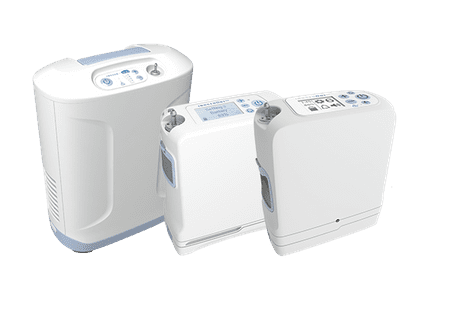
Every home oxygen system has a different performance characteristic, with its own set of capabilities and applications. Your doctor should be aware of product variability in performance when identifying specific systems that would work for you.
Your Oxygen Therapy Options
There are so many home oxygen therapy options to choose from that to the point where it is notoriously difficult to know what equipment is right for you, what is available and the capabilities and drawbacks of each device.

So while your doctor will typically prescribe you a flow rate and frequency for home oxygen therapy based on the results of your pulmonary function, the oxygen provider is expected to supply the necessary equipment based on your prescription and recommendations from your doctor. Therefore, it should be evident that it is important to work with the most trustworthy oxygen providers that supply the most trusted names in oxygen manufacturing.
Flow rates
At one point in time, there were only continuous flow oxygen devices, until intermittent-flow devices were introduced in 1983. The continuous flow devices distribute the oxygen at a consistent rate, even while you exhale. Intermitted-flow devices were created to conserve the oxygen that is wasted while exhaling. Intermittent-flow devices only admit oxygen when the user inhales, and it will pause during the exhale.
Both continuous flow devices and intermittent-flow also known as pulse flow devices, are still used today and the flow rate you use will depend on your oxygen requirements that will be established by your doctor. From there it will be the responsibility of your oxygen supplier to adhere to your oxygen requirements and match you with a device that will meet these needs.
There are three main forms of home oxygen therapy that offer both continuous and pulse flow operations listed in the following sections.
Oxygen gas
.jpg)
Oxygen gas can be stored in a portable tank also known as compressed gas systems. You would use a larger stationary concentrator while you are at home, and you would have a smaller oxygen tank that can be taken with you outside the home.
The portable oxygen tanks are very small and only deliver oxygen in pulses, not continuously in order to save oxygen, so you will not run out. This is of course not an option for everyone, because many people do need the continuous flow of oxygen in order to reap the benefits of oxygen therapy.
Liquid oxygen
Liquid oxygen can be stored in a portable tank, but the difference between the gas and liquid oxygen is how the liquid form is more highly concentrated, and more oxygen can fit in a smaller tank. Active people would prefer this method because it is much more portable, but it will still need to be refilled often.
Most people with liquid oxygen and oxygen gas systems are able to get their oxygen delivered to their home, and this will depend on your location.
Portable oxygen concentrators

Portable oxygen concentrators are the most portable option. An oxygen concentrator is a device that takes oxygen from the room, filters out impurities, and concentrates the air into medical-grade oxygen. The most obvious advantages of portable oxygen concentrators is that they are less expensive and don’t require refilling.
So while there are only 3 main forms of oxygen therapy, the diversification between each method is vast, and you may want to read more about the comparison between oxygen device systems, you can do so by clicking here to read Oxygen Concentrators vs. Oxygen Tanks: A Simple Comparison Guide.
A lot like buying a car, the next step, is deciding which brand of POC you will choose and then deciding on the model you want, luckily your choice are limited by your oxygen prescription, but for most people they will have more than one option, and picking the right device can be overwhelming.
Here are a few of the most trusted names in oxygen manufacturing.
Oxygen Manufacturing Companies
Of all of the oxygen manufacturers out there there are a few that continuously outperform their competitors, bringing oxygen users the most efficient, cost effective, overall best oxygen equipment to the market every year, for more reasons than one.
- Inogen
- ResMed
- Philips Respironics
- Drive Medical
At LPT Medical, quality is the only option. Which is why, LPT Medical offers products from all of the most reputable manufacturers in the industry. These are the companies that are pushing the boundaries of what’s possible for patients suffering with a debilitating respiratory condition. And by offering these brands, we ensure that more people around the country have access to the most state-of-the-art oxygen therapy equipment in the world.

Best Selling Portable Oxygen Concentrators
The make and model of your device will be narrowed down based on your oxygen requirements. From there, one of our knowledgeable respiratory specialists at LPT Medical reviews your needs and matches you with a variety of devices that vary in weight, battery life, and other factors. Our customers have reviews our specialists ability to pick out the best device, and we are thrilled with our performance.
Our selective and integrated process working with every customer on a personal level has given us worldwide recognition as one of the most trusted names in the world of oxygen therapy products offering home oxygen concentrators, portable oxygen concentrators, CPAP and BiPAP machines, and all the accessories you need to make the most of them.
That being said, we know which devices work for many people and for those who do qualify for the following portable oxygen concentrators, are always our happiest customers!
Inogen One G5 and the Inogen One G3
The Inogen One G5 portable oxygen concentrator in the best selling pulse flow oxygen device there is because it meets mostly every oxygen patient’s needs. It is powerful enough to cover a user’s oxygen prescription, by going up to a level 6 which is 1260 ml or oxygen per minute.
The battery life of the Inogen One G5 is unbeatable, the Inogen One G5 Double Battery provides the same reliability as the G5 Single Battery but adds up to 13 hours of additional battery life on a single charge.

So this device can go with you anywhere, and last for hours, but it is also very lightweight. You can carry the One G5 with you in the One G5 backpack or the custom carrying case, but with either method you will barely notice the 4.7 pounds.
The Inogen One G3 goes up to a level 5 in pulse flow output, and weighs the same as the One G5. it is a great option for people who don’t mind having older generations that are still high quality and reliable. The One G3 is still rated the number one pulse flow oxygen concentrator because of its long-standing record and dependable results. Not to mention the carrying case is designed in a classic and sleek style, so it doesn't look like a medical device
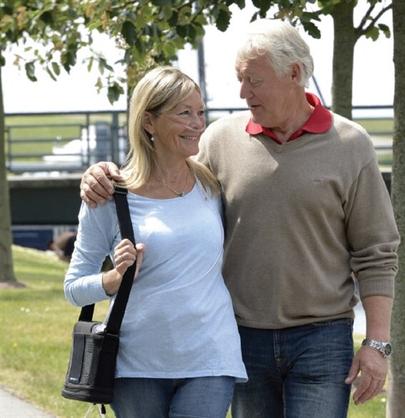
The 8-cell battery that comes with the One G3 is very powerful, but you can also get the Inogen One G3 16-Cell Battery if you value that extra long lasting battery life.
The G3 is also one of the quietest portable oxygen concentrators available, but it also help you pay attention with audible alerts in case of a power outage, no breath detected alarms, and oxygen purity checks. If your oxygen level ever falls below required levels, the One G3 will let you know immediately.

Caire Freestyle Comfort
The Caire Freestyle Comfort portable oxygen concentrator has been compared to the Inogen One G5 in similar respects to its long lasting battery life and lightweight design. The Freestyle Comfort is even lighter than the One G5 but the battery doest last quite as long.
Similarly to the One G5 and One G3, the Freestyle comfort has two battery options, the Caire Freestyle small battery, and the Caire Freestyle large battery.

Respironics SimplyGo
The Respironics SimplyGo is the most lightweight portable oxygen concentrator that offers both pulse flow and continuous flow, making this device a hot commodity for people who switch between flow settings.
The long lasting battery life is another huge selling point because people can go longer without having to plug in their oxygen to the car or outlet. When the machine does need to be recharged it is as easy as changing your cell phone, and you can continue to use it as it charges.

Making the Most Out of Your Oxygen Device
In order to take advantage of all of our devices, including the ones not listed above, you can purchase extra batteries, external chargers, backpacks and carrying cases, and more. Oxygen accessories are designed to make using oxygen therapy easier and more comfortable, and you will quickly learn what aspects of oxygen therapy you want to make more comfortable.

For example, if you notice that the oxygen tubing is putting a lot of pressure on your ears, there are ear pads available to accommodate that pain.
If you notice that your battery is dying too quickly, you can upgrade to the larger battery for extended use.
Devices like the the Inogen one G3 have backpacks and rolling backpacks available, to make carrying the 5 pound device even easier, you can find those items by following the links below:
Inogen One G3 Rolling Backpack by Portablez
GO2 Carryall Inogen One G3 Carrying Bag
If you notice that your tubing tends to get tangled there are Tidy Tubs Oxygen Supply Tubs available to stop this from happening
Here are 4 other ways to take advantage of your oxygen concentrator

1. Consider buying additional oxygen concentrator batteries.
Having an additional oxygen concentrator battery is extremely important for people who enjoy spending extended time away from their home or car. An extra battery can be the difference between having to worry about leaving an event early versus living stress free knowing you have plenty of time with pure medical grade oxygen. This particularly applies to patients who do not get as much battery life, either due to their high-flow rate, or their device just doesn't have that long lasting battery that some do.
2. Keep your spare batteries fully charged and do not forget to rotate them.
Keeping an extra battery without a charge for extended periods of time can actually damage the battery. Oxygen users should always store spare batteries that are fully charged. this is not only better for the battery life overall, but keeping batteries fully charged and ready, allows you to switch batteries at any time without having to worry about damaging them or your POC. You should also rotate batteries if you have more than two and always switch to a fully charged battery.
Tip: If you aren't going to use your spare batteries, store them at a 50% charge to ensure you don't damage any battery cells.
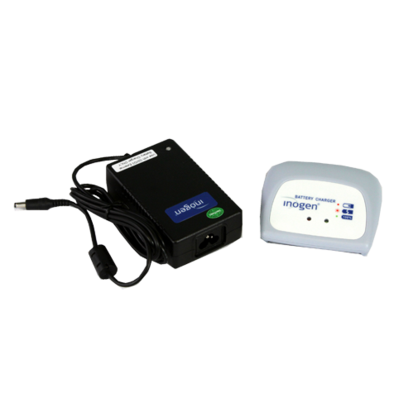
3. Utilize the accessory bag that comes with the package
Most units will come with a custom carrying case, few do not. Theses accessory bag vary in size and color based on the type of concentrator you have has. The accessory bag is an excellent organizational tool that helps you arrange the unit accessories in one particular location without having trouble finding them or risk losing them. Accessory bags usually have padding, zipper or velcro, and easy access to keep the contents safe.
4. Utilize the DC Power Supply.
All POCs come with a DC power supply that can be plugged into the cigarette lighter of a car. Small pulse flow units are totally functional on the DC power supply, which means you can use your device on any flow rate settings, and recharge the battery at the same time. However, the constant flow units carry a few limitations when using the DC power supply. Generally, uninterrupted flow units will continue to work and charge on pulse flow settings 1-4 as well as continuous flow settings as much as 2 LPM.
Overview
Oxygen can be a life saving therapy if you are adhering to your oxygen prescription correctly. If you start to take advantage of you oxygen device, you can find even more independence and more freedom than you had before you needed oxygen. All this requires in knowledge and trust in the process that this life saving therapy, can make a huge difference in the quality of you life.


 So we can find the best portable oxygen concentrator for your needs!
So we can find the best portable oxygen concentrator for your needs!













